Need help planning an itinerary for 2 weeks in Tanzania & Zanzibar?
Then you’re in the right place!
Located in East Africa, Tanzania is loved for its diverse array of unforgettable experiences. I’m just back from traveling through Tanzania myself, and it was one of the most memorable trips of my life!
Hiking Mountain Kilimanjaro, going on safari in the Serengeti, visiting a Maasai Village, and relaxing on the white sand beaches of Zanzibar are just a few of the many things to do in Tanzania.
But, with so many options across 365,794 square miles, it can be tricky to plan an itinerary.
Luckily, that is where this detailed guide comes in. Keep reading for an in-depth 2 week itinerary for Tanzania and Zanzibar, including information on where to go, things to do, logistics, important tips, safety information, and costs.
Short on time? I’ve also included 5, 7, and 10 day itinerary options too!
 Short on time? My top recommendations for your 2 week Tanzania itinerary include:
Short on time? My top recommendations for your 2 week Tanzania itinerary include:
 Top Hotels:
Top Hotels:
–Gran Meliá Arusha (Arusha)
–Lahia Tented Lodge (Serengeti)
–Maramboi Tented Lodge (Lake Manyara)
–Kisiwa on the Beach (Zanzibar)
 Top Multi-Day Tours: While my trip was organized by Curious on Tanzania, if you’d prefer to book your own travel a few top-rated options include:
Top Multi-Day Tours: While my trip was organized by Curious on Tanzania, if you’d prefer to book your own travel a few top-rated options include:
–3-Day Tarangire, Manyara & Ngorongoro Budget Lodge Safari
–5-Day Camping Safari Tarangire, Serengeti & Ngorongoro Crater + Maasai Village
–7-Day Private Midrange Safari with Serengeti & Ngorongoro Crater
 Top Day Tours:
Top Day Tours:
–Explore Zanzibar’s Southeastern Charm (Zanzibar)
–Mount Kilimanjaro Day Hike (from Arusha)
–Ngorongoro Crater Day Trip (from Arusha)
–Materuni Waterfalls, Coffee Tour & Kikuletwa Hot Springs (from Arusha)
–Sunrise Hot Air Balloon Safari (Serengeti)
 Packing: Click here for my recommended safari packing list
Packing: Click here for my recommended safari packing list
 Travel Insurance: SafetyWing (budget-friendly) & World Nomads (robust)
Travel Insurance: SafetyWing (budget-friendly) & World Nomads (robust)
 Staying Connected: Airalo eSIM
Staying Connected: Airalo eSIM
Tanzania Itinerary Planning Resources
But first, before we go over a Tanzania 2 week itinerary, I invite you to grab access to my free Ultimate Travel Planning Kit—which includes 40+ travel resources from printables to quizzes to itineraries—all meant to help you explore the world beyond the guidebook!
Some highlights of the kit include:
- Free “Where Should You Travel Next?” personality quiz
- Pre-plotted Google Maps for 45+ destinations (including Tanzania!)
- Travel budget calculators to help you save money
- Printable travel journal with writing prompts
- Packing lists for different types of trips
- And more!
Once you’ve grabbed your copy, keep reading this Tanzania blog for tips on planning the best 2 week itinerary!
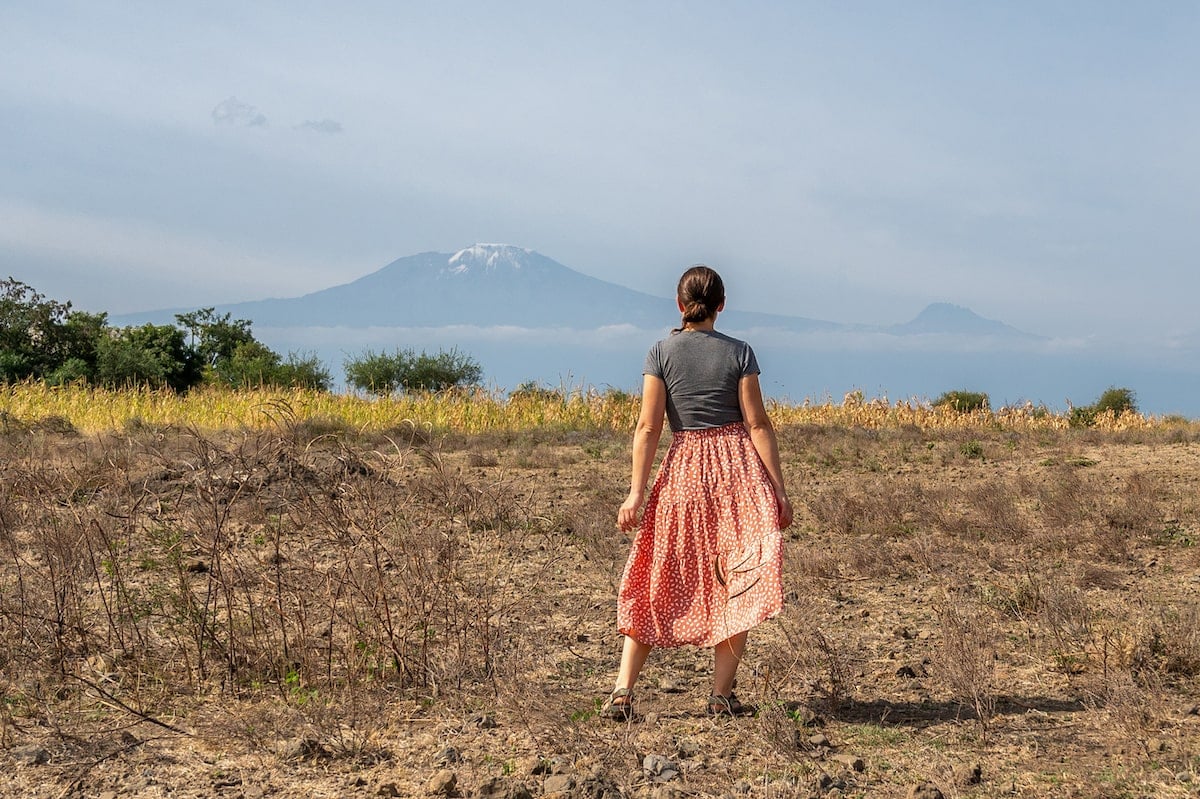
Where Is Tanzania?
Located in East Africa, Tanzania is bordered by Kenya and Uganda to the north, Rwanda, Burundi, and the Democratic Republic of the Congo to the west, and Zambia, Malawi, and Mozambique to the south. The eastern border is the Indian Ocean.
Tanzania also includes the tropical islands of Zanzibar, just off the coast, which are known for their gorgeous white sand beaches.
How To Get To Tanzania
Most international travelers visiting Tanzania will fly into Julius Nyerere International Airport (DAR) in Dar es Salaam, Kilimanjaro International Airport (JRO) near Arusha and Moshi, or Abeid Amani Karume International Airport (ZNZ) in Zanzibar.

Getting Around Tanzania
There are many ways to travel around Tanzania, including:
Private or group tour. I had a private guide and driver while exploring Tanzania, though group tours are also an option and include transportation at a more budget-friendly price, albeit with less flexibility.
Public transportation. Buses are a popular choice for budget-friendly long-distance travel, with several companies offering regular routes between major cities. The downside is that these can take a long time, so if you have it within your budget to opt for a domestic flight, I’d recommend that.
Self-drive. After visiting Tanzania, I can’t imagine navigating the bumpy and rough roads—not to mention potential close wildlife encounters—of some of the national parks. Personally, I wouldn’t feel safe self-driving, at least if doing a safari itinerary; but, some travelers choose this option so I wanted to mention it.
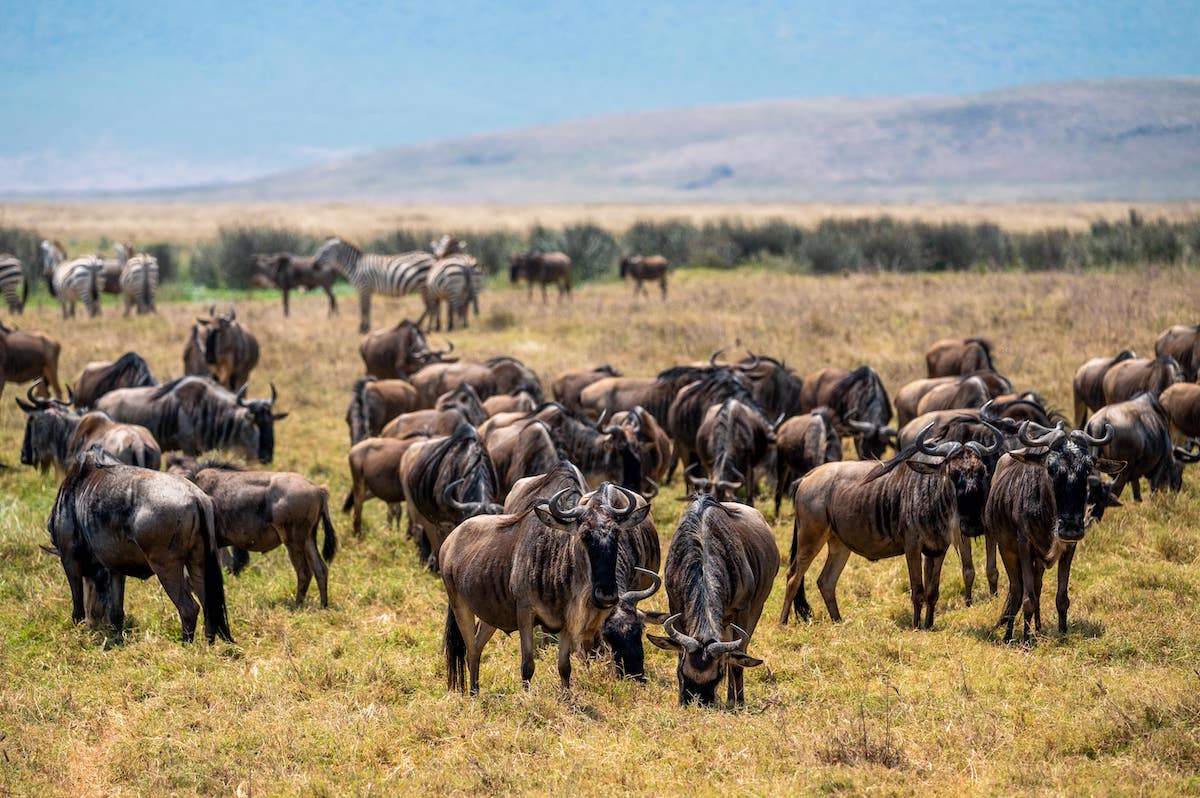
Flights. There are airports of all sizes around Tanzania, which helps make taking a quick domestic flight easy. For instance, after my safari, I took an 80-minute flight from Arusha to Zanzibar.
Ferry. If you’re going to Zanzibar from Dar es Salaam, the ferry takes about 80 minutes and costs around $129.
Dala-Dala. For short distances within cities, towns, and villages, you can hop on a dala-dala (minibus). These can get extremely crowded and bumpy, so while budget-friendly they won’t be the most comfortable way to get around.
Taxis and ridesharing. Uber and Bolt are available in certain cities, like Dar es Salaam, with Bolt tending to be cheaper and more popular. You can also use local taxi services to get around.
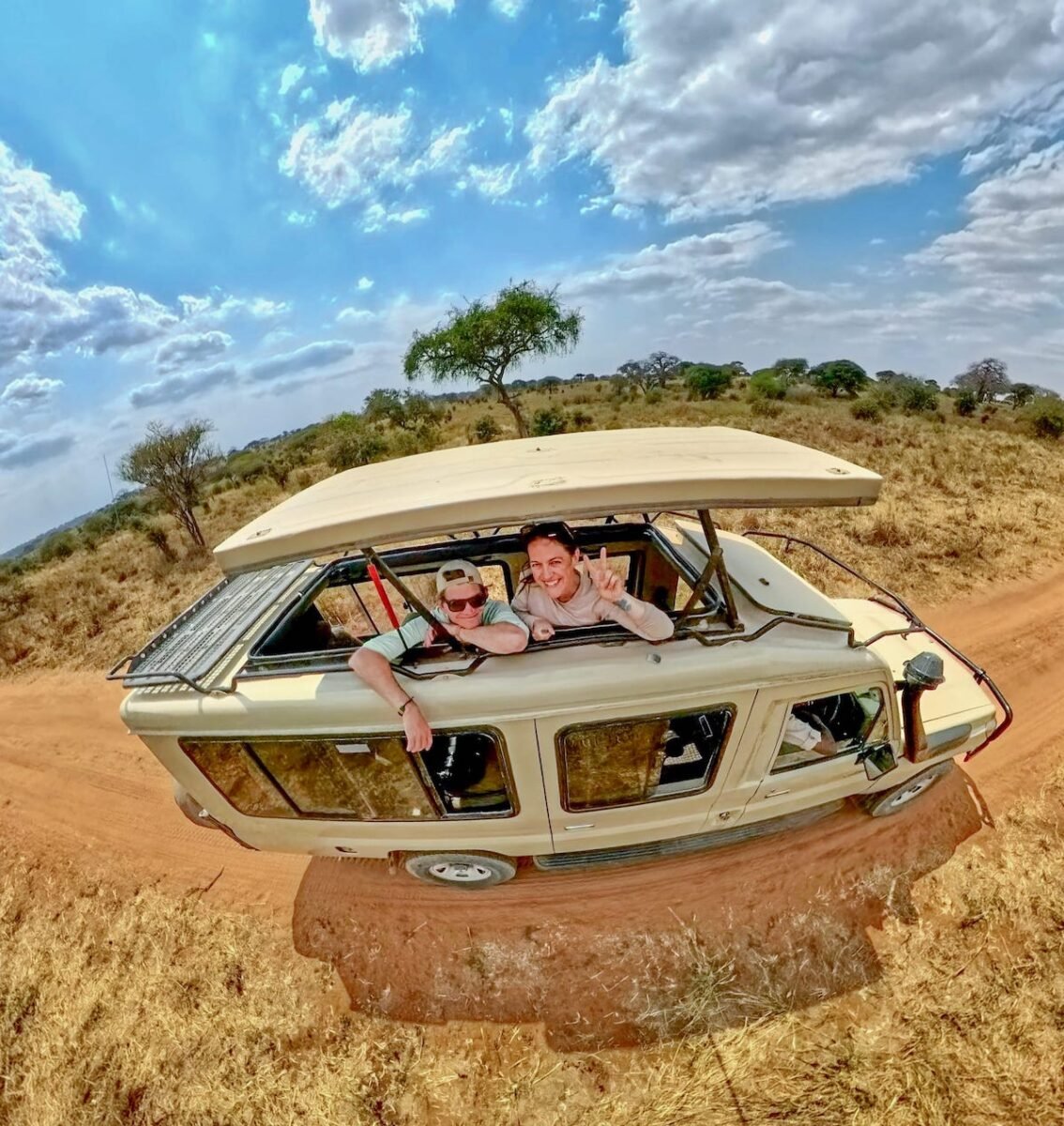
Best Time To Visit Tanzania
The best time to go to Tanzania is during the dry season, from late June to October. The weather is cooler and clear, perfect for exploring national parks and climbing Kilimanjaro, and you can avoid heavy rains that make viewing wildlife tricky.
While the Great Migration takes place all year, you can increase your chances of seeing a river crossing in mid-July through mid-September.
If you’re visiting Tanzania on a budget, consider going in November and December. While it’s the rainy season, this time sees more short rains (vs long rains in April and May) as well as more travel deals and fewer crowds.
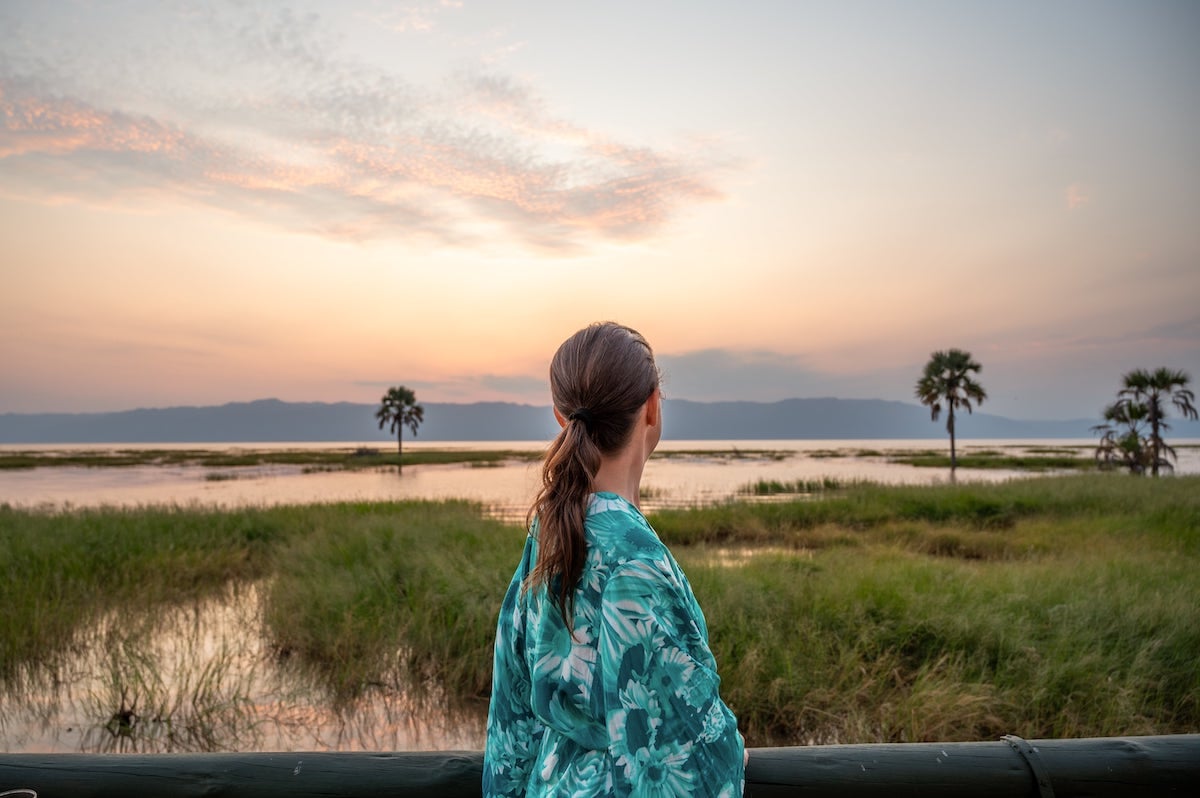
Is Tanzania Safe?
According to Travel-Safe Abroad, your risk of being the victim of a violent crime is low, though you should be aware of common scams and take precautions to avoid pickpockets.
Personally, I felt very safe while traveling Tanzania. I did encounter a few scams, but I never felt like I was physically in danger. Of course, I always recommend keeping travel safety tips in mind as well as bringing some travel safety gear with you. My top essentials include:
 Clever Travel Companion Pickpocket-Proof Garments
Clever Travel Companion Pickpocket-Proof Garments Speakeasy Travel Supply Pickpocket-Proof Scarf
Speakeasy Travel Supply Pickpocket-Proof Scarf  She’s Birdie Personal Safety Alarm
She’s Birdie Personal Safety Alarm
The main safety concern I had was related to health, as malaria is prevalent in Tanzania (though your doctor can prescribe you malaria tablets). Additionally, insects like killer bees and tse tse flies can be deadly. I was once misdiagnosed with sleeping disease from a tse tse fly bite!
In short, consult a travel doctor before going to Tanzania to make sure you’re medically prepared for your trip.
Note that the US Department of State recommends avoiding travel to the Mtwara Region in southern Tanzania due to the threat of terrorism.
Additionally and sadly, homosexuality is illegal in Tanzania so LGBTQ+ travelers should exercise caution. Here is a first-hand account from an LGBTQ+ traveler who visited Tanzania if you’d like additional advice.
Tanzania Travel Map
To help give you a lay of the land, here is a Tanzania travel map with the places mentioned in this itinerary pre-plotted:
Click here for an interactive version of the above Google map.
2 Week Tanzania Itinerary: Quick Overview
Here is a quick glance at our 2 week Tanzania itinerary. Note that all of the hotels (aside from Weru Weru River Lodge) are luxurious, so you may also want to factor in time to enjoy the properties—especially Gran Meliá Arusha, which offers numerous activities.
Moshi (2 nights)
- Stay: Weru Weru River Lodge
- Top Activities: Do a day hike up Mount Kilimanjaro & have a cultural experience by touring Rundugai Village
Arusha (2 nights)
- Stay: Gran Meliá Arusha
- Top Activities: Visit Arusha National Park for a walking safari and a day hike up Mount Meru
Serengeti National Park (2 nights)
- Stay: Lahia Tented Lodge
- Top Activities: Enjoy safari game drives around the Serengeti and do a sunrise hot air balloon safari
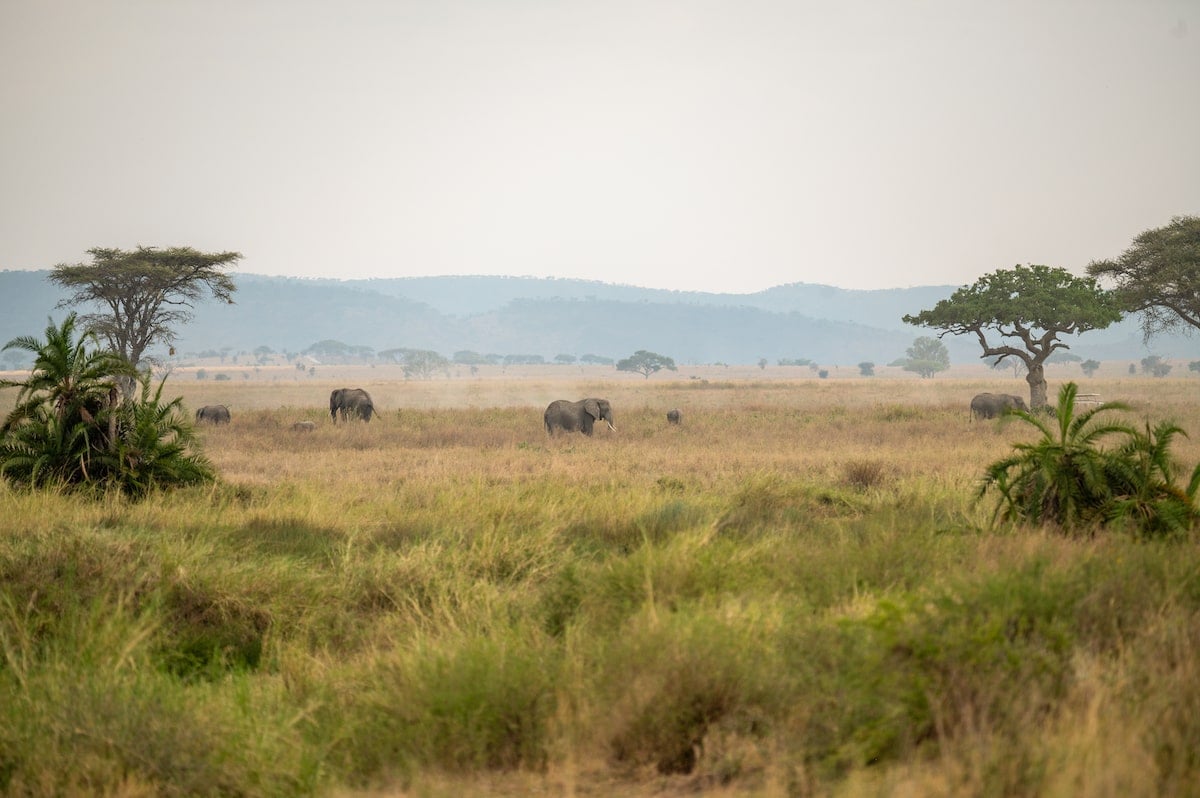
Ngorongoro Conservation Area (1/2 day)
- Stay: I stopped here along the way from Serengeti to Tarangire National Park, so I didn’t stay overnight; however, there are many nearby lodges
- Top Activities: Do a game drive through the crater while driving from the Serengeti to your next accommodation
Tarangire National Park & Lake Manyara (3 nights)
- Stay: Maramboi Tented Lodge
- Top Activities: Do a safari game drive through Tarangire National Park and support local women while learning about local life on a tour of Mdori Village
Zanzibar (3 nights)
- Stay: Kisiwa on the Beach
- Top Activities: Relax on the beautiful Paje Beach and do a historical tour of Stone Town
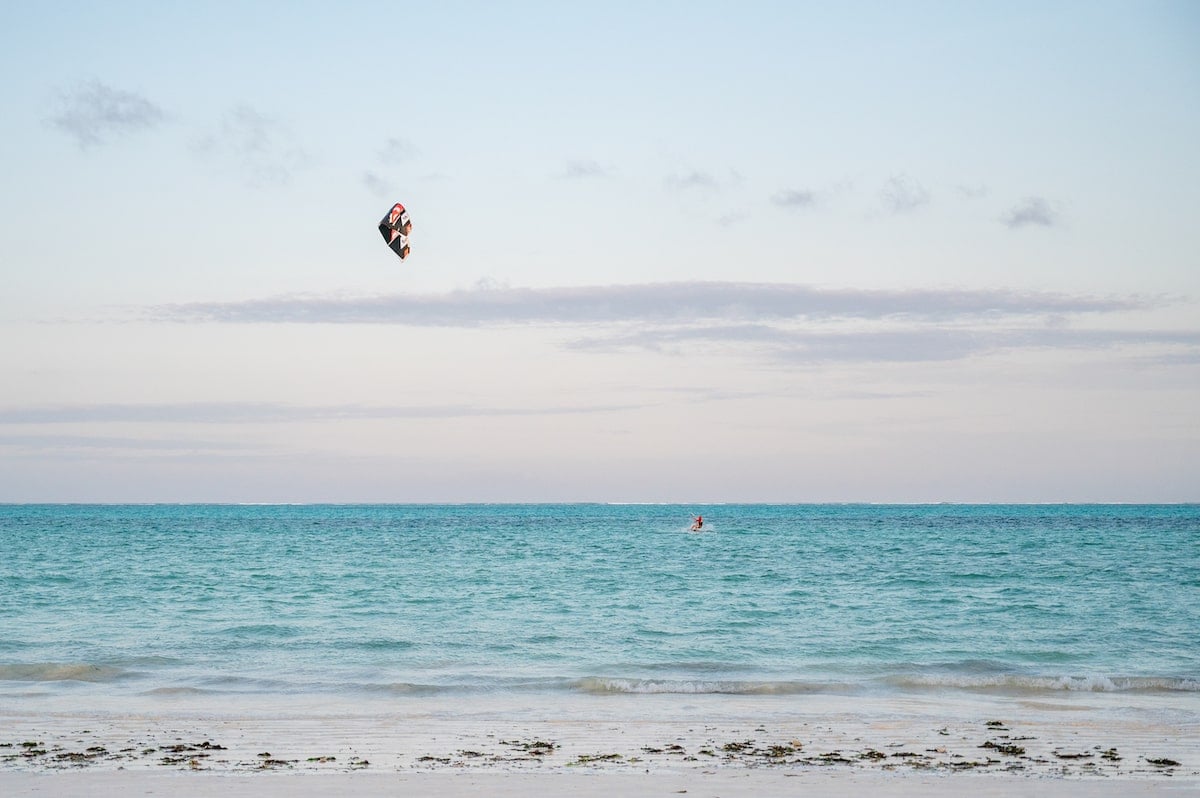
2 Week Tanzania Itinerary: Detailed Breakdown
Now that we’ve quickly gone over where you should go for your Tanzania 2 week itinerary, let’s break down exactly what you should do and what the experience is like.
Again, this itinerary for Tanzania is based on a trip my husband Andy and I planned with the help of Curious on Tanzania. It was a private tour, which allowed for plenty of flexibility too.
Moshi
Length: 2 nights
Distance: About 40 minutes from Kilimanjaro International Airport
Guide: Our guide, Bosco, is a freelance mountain guide, so if you’re looking to hike or do a walking safari, you can contact him on WhatsApp (+255 757 725 725)
Accommodation: Weru Weru River Lodge, a family-friendly 3-star hotel that is clean and comfortable, and has a pool, spa, restaurant, rooms with balconies and air conditioning, and camping facilities if you’d like to save money. The only downside is there are so many kids onsite it can be pretty loud, but other than that I enjoyed this hotel.
Tours: Click here for tours from Moshi
Day 1) Get acclimated
Spend the first day of your Tanzania itinerary resting and acclimating to your new time zone.
Day 2) Hike Mount Kilimanjaro
Kick off your trip with a bucket list adventure: hiking Mount Kilimanjaro, Africa’s highest mountain and the world’s highest single free-standing mountain at 5,895 meters above sea level.
If you have the time to allot to the full Mount Kilimanjaro hike—which takes 5-6 days—that is also an option.
However, if you’re only spending 2 weeks in Tanzania, I recommend doing this moderate day hike in Kilimanjaro National Park that begins at the Marangu Gate.
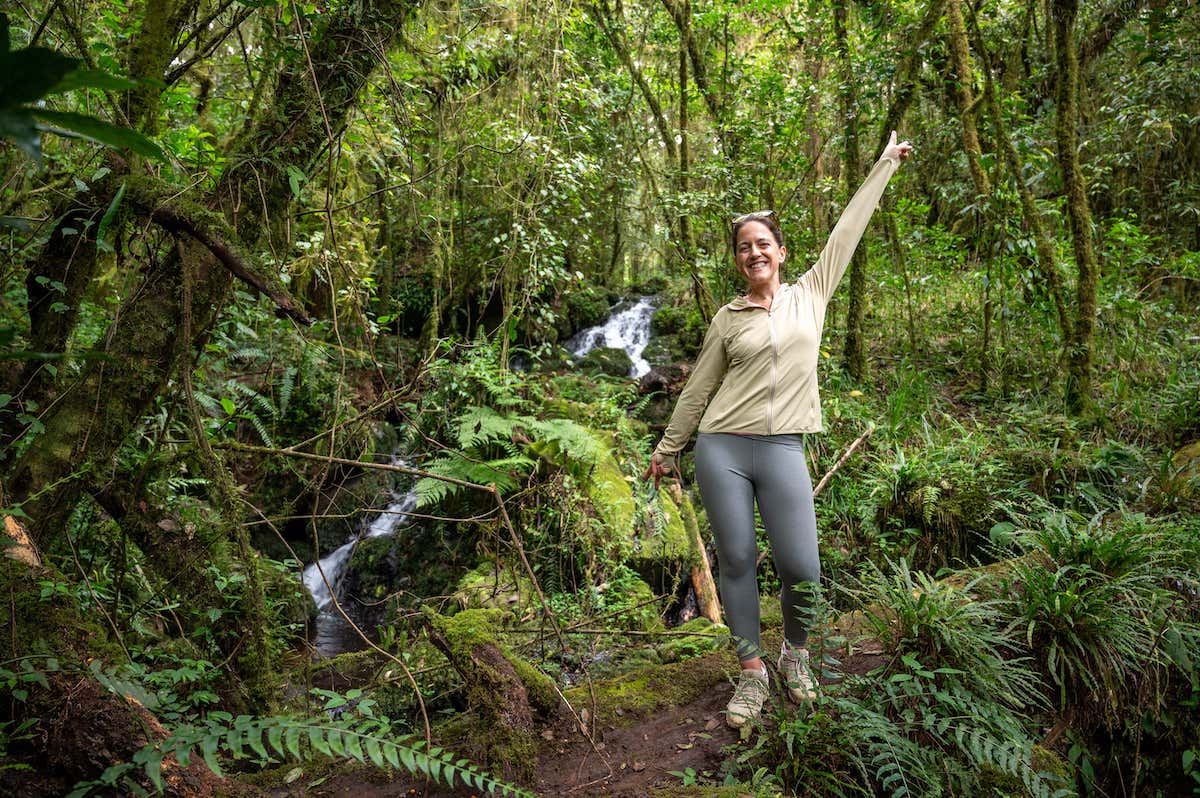
 Kilimanjaro National Park entrance fees for non-East African residents are $70 for adults and $20 for children aged 5-15.
Kilimanjaro National Park entrance fees for non-East African residents are $70 for adults and $20 for children aged 5-15.
You’ll hike through tropical rainforest with lush ferns, dangling vines, and moss-covered trees lining the path.
Along the way, you’ll pass a small waterfall that makes for a nice photo opportunity. We also saw loads of blue monkeys (which are actually grey) and black-and-white colobus monkeys jumping from the trees and grooming their babies.
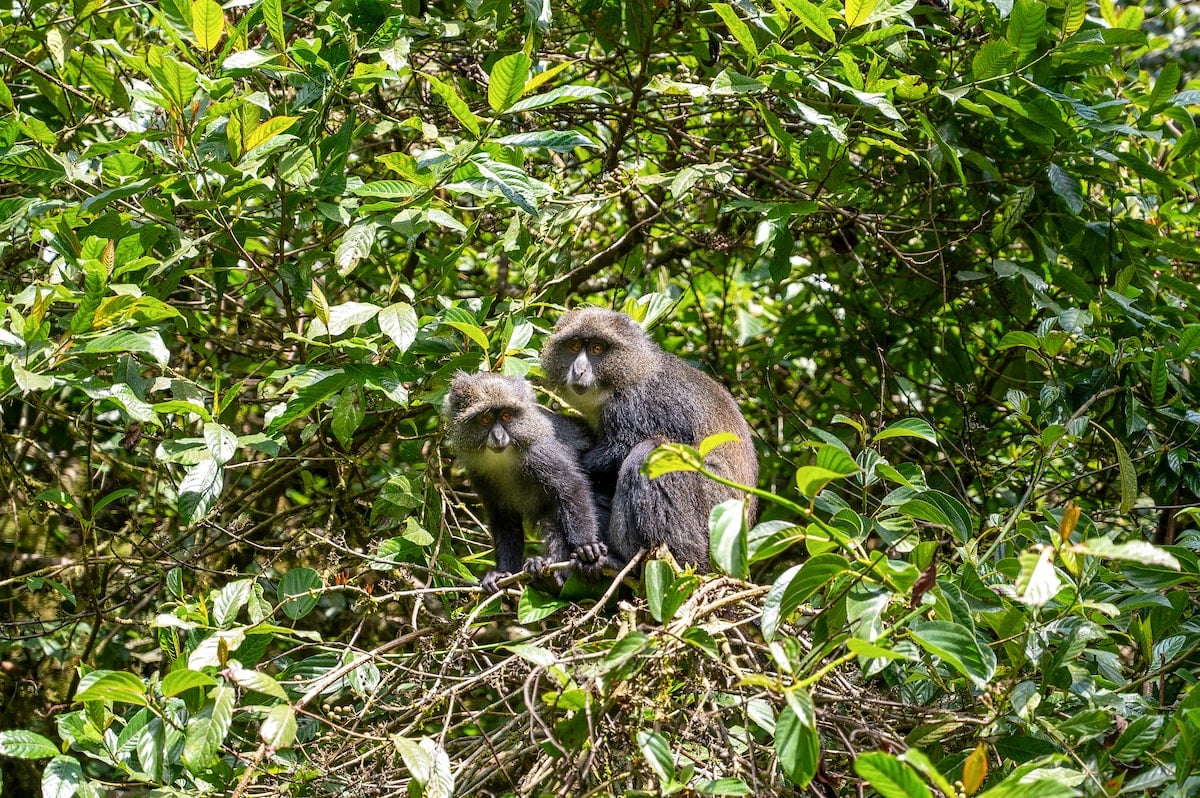
Continue making a gradual ascent up roots, rocks, and wet ground before reaching Mandara Hut at 2,720 meters. It took us a little less than 3 hours.
It’s a cool spot full of friendly hikers resting and refueling. While the views from the hut aren’t spectacular—you’ll mainly see tree tops—on a clear day you can walk an additional 30 minutes uphill to Maundi Crater for a view of Mount Kilimanjaro. According to our guide, Bosco, your best chance for views is in the very early morning.
Unfortunately, we weren’t so lucky that day, but it was still a fun way to spend some time on Mount Kilimanjaro!
 Tip: You’ll want a rain jacket for this hike, though if you forget someone sells them across from the parking lot for $10 per day.
Tip: You’ll want a rain jacket for this hike, though if you forget someone sells them across from the parking lot for $10 per day.
You can also get a view of Mount Kilimanjaro from Moshi. Just ask your driver to go somewhere just outside of the main town so you can have a more natural view:
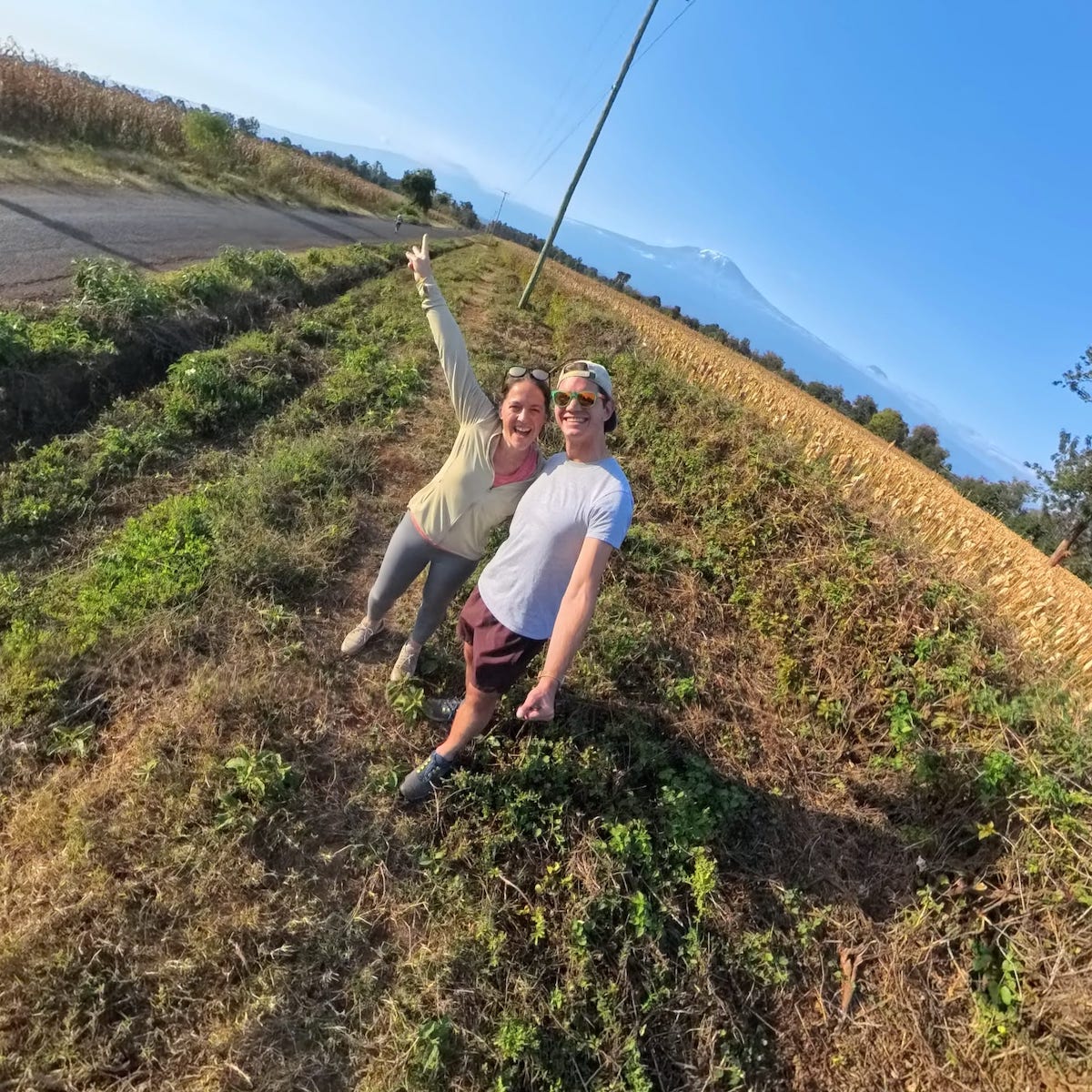
Arusha
Length: 2 nights
Distance: About 90 minutes from Moshi.
Accommodation: Gran Meliá Arusha, a 5-star hotel with an amazing view of Mount Meru. You’ll enjoy gorgeous rooms with balconies and rain showers, multiple restaurants, a rooftop bar, a spa, and onsite activities like cooking and weaving classes.
Tours: Click here for tours from Arusha
Day 3) Tour Rundugai Village & visit Kikuletwa Hot springs
After a buffet breakfast at Weru Weru River Lodge, check out of the hotel and set off for the day’s adventures—starting with a walking tour of Rundugai Village.
The tour is part of a community-based tourism project meant to help boost visitor numbers, promote cultural tourism, and support Rundugai Village projects through tourism dollars.
If you agree that travel is about the people you meet, you’ll love this tour.
After an introduction to the village, we visit the home of Susana—the village midwife who has helped women from Kenya to Denmark get pregnant using 100% natural medicine, particularly teas made from tree bark—as well as Paulina, a local herbalist using roots and leaves to create medicines passed down through generations.
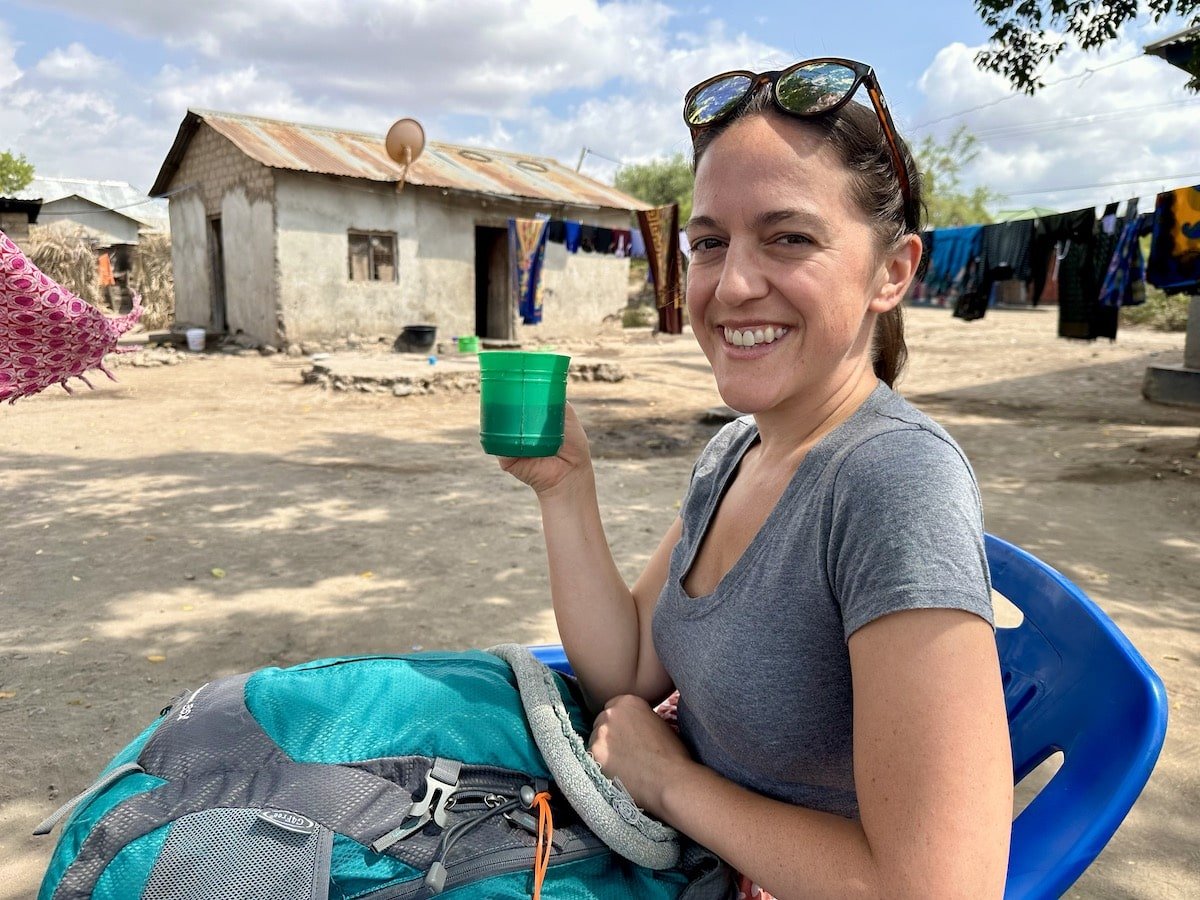
Afterward, we head to Dragon Street Pub for some banana beer (mbege)—a specialty of the Chagga tribe in the Kilimanjaro region made from sweet banana, water, and sprouted finger millet.
The beer serves many purposes: ritual offerings to ancestors, ceremonies like weddings, and settling disputes (the village elder decides who is wrong and that person has to make the other banana beer).
After the beer, we enjoy a delicious lunch made by a group of local women. They welcome us with dancing, singing, and a delicious buffet of homemade local and tribal dishes—like makande, a stew made from maize and beans traditionally eaten by the Pare tribe.
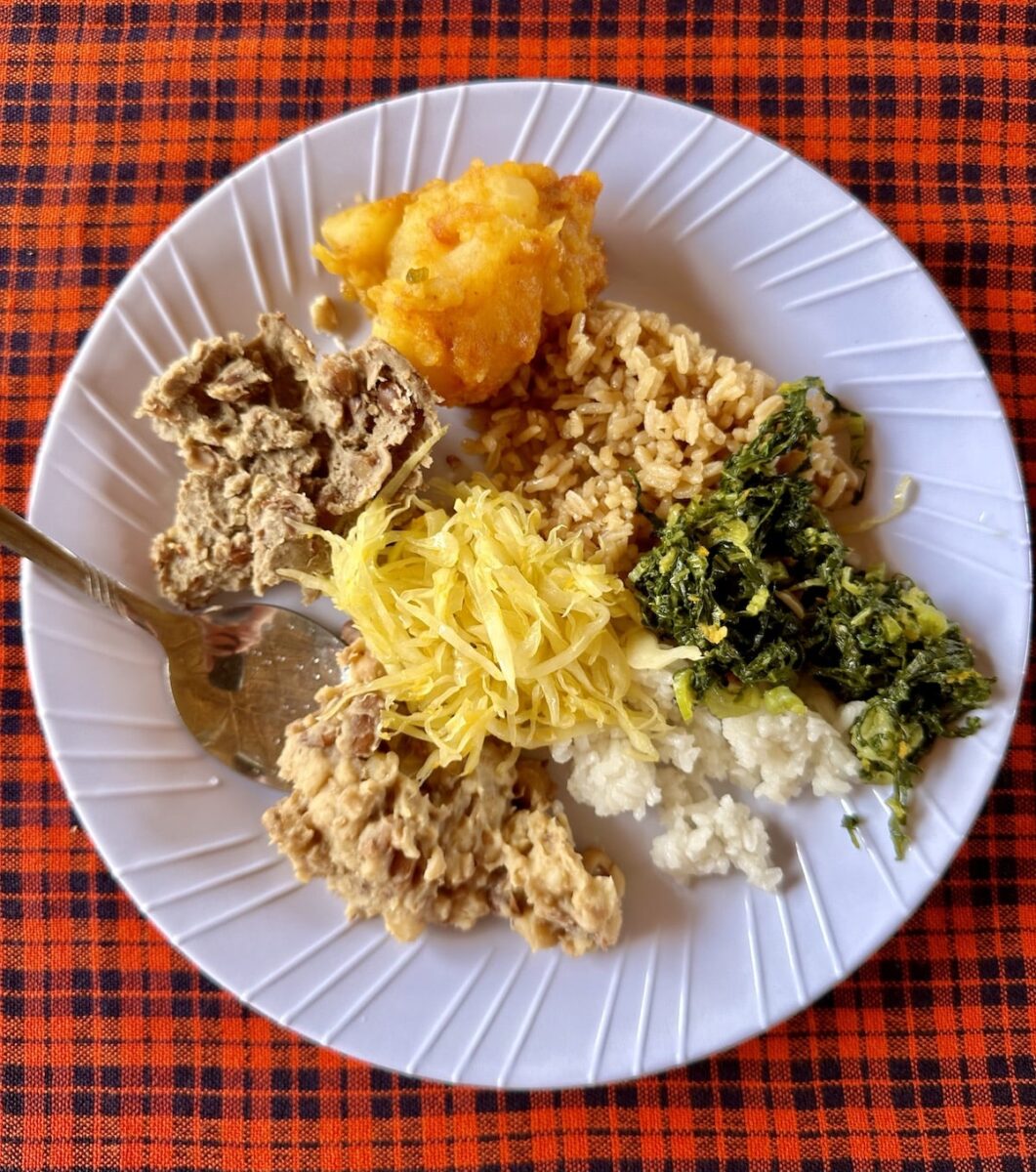
The tour finishes with a swim in Kikuletwa Hot Springs (aka Chemka Hot Springs), which has two warm crystal pools. On one end, there is a swing to catapult yourself in, while in the middle there is a connecting channel shaded by palm trees. If possible, go on a weekday to avoid the crowds.
 Entry to the hot springs is included with the tour, though if you go on your own it’s $5 USD. You can also rent an inner tube for 5,000 Tanzanian Shillings and a towel for 7,000 Tanzanian Shillings. There are changing rooms (with dusty dirt floors, so bring a bag you don’t mind getting dirty).
Entry to the hot springs is included with the tour, though if you go on your own it’s $5 USD. You can also rent an inner tube for 5,000 Tanzanian Shillings and a towel for 7,000 Tanzanian Shillings. There are changing rooms (with dusty dirt floors, so bring a bag you don’t mind getting dirty).
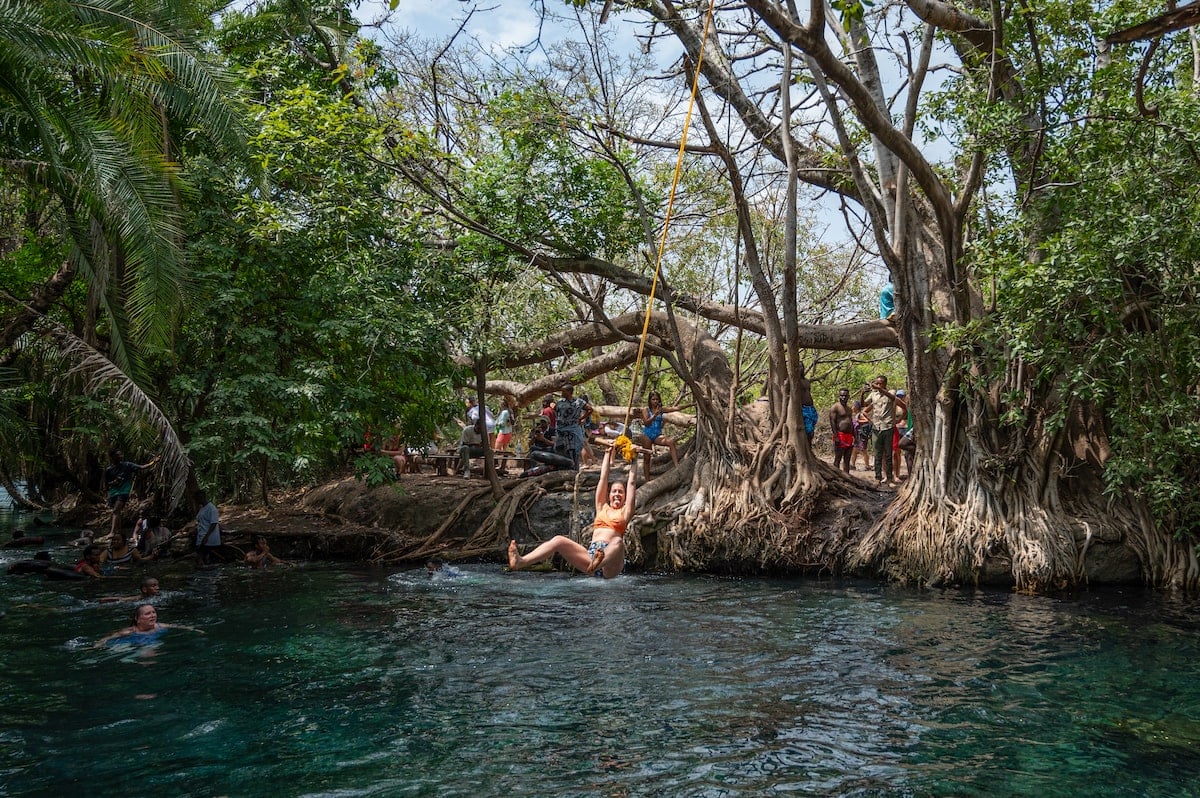
After the hot spring, head to your next destination, the Gran Meliá Arusha in Arusha, enjoying amazing views of Mount Kilimanjaro and Mount Meru along the way.
This 5-star hotel is a highlight of this 2 week Africa itinerary. Spend some time wandering around the pool and landscaped grounds before heading up to their rooftop bar for apps, cocktails, and an incredible view of Mount Meru:
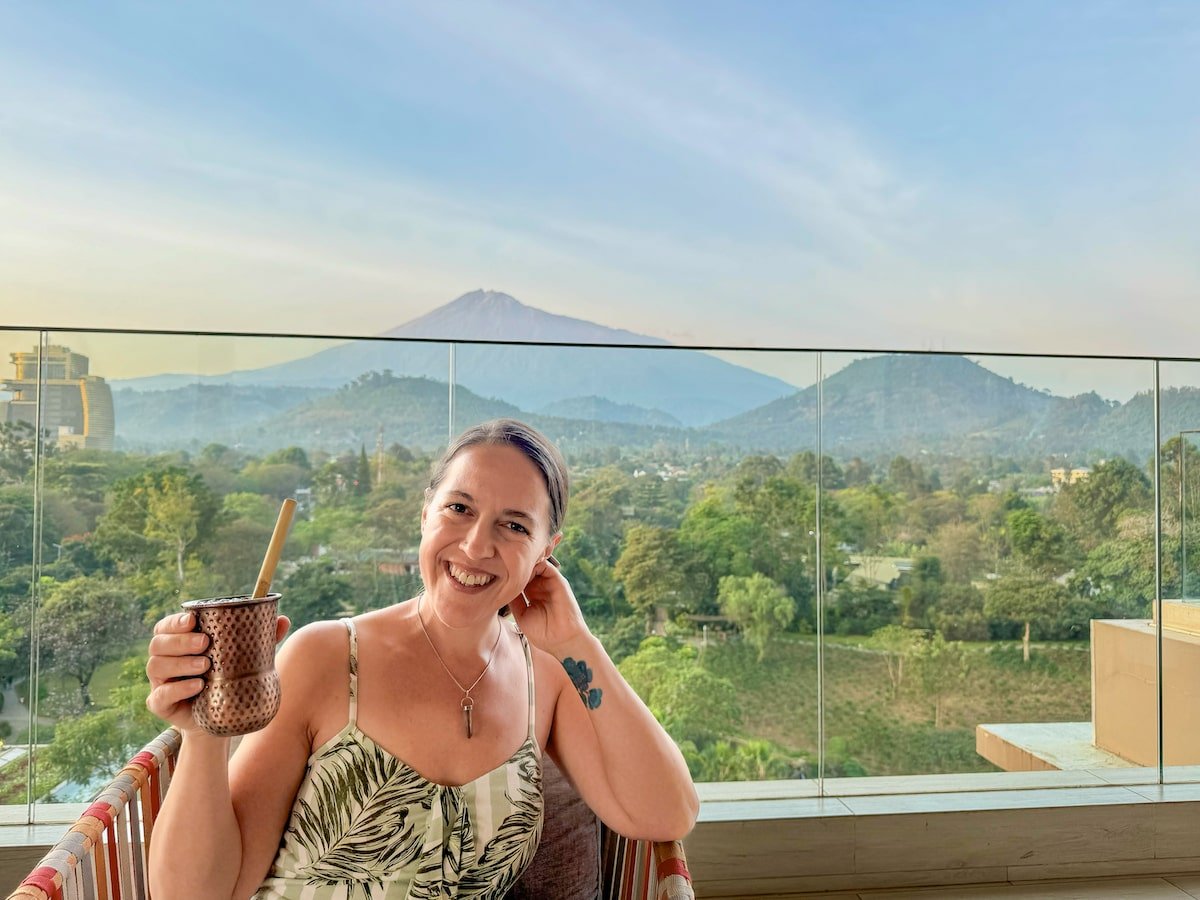
 Tip: If you want to cut either the Mount Kilimanjaro day hike or Rundugai Village tour from your Tanzania itinerary, consider adding a day to just enjoy the resort facilities and lounge by the pool at Gran Meliá Arusha.
Tip: If you want to cut either the Mount Kilimanjaro day hike or Rundugai Village tour from your Tanzania itinerary, consider adding a day to just enjoy the resort facilities and lounge by the pool at Gran Meliá Arusha.
Day 4: Go on a walking safari & hike Mount Meru in Arusha National Park
If you have time in your Tanzania itinerary, the full Mount Meru hike takes 3 or 4 days to summit and is an unforgettable experience. It’s the country’s second-tallest mountain at 4,566 meters and offers beautiful views—including the opportunity for a stunning sunrise over Mount Kilimanjaro from the summit.
But, if you’re only in Tanzania for 2 weeks and want to do safari and beaches, a Mount Meru day hike will make more sense.
For our day hike, we enter Arusha National Park through the Ngongongare Gate to sign in and get our permits before continuing to the Momella Gate.
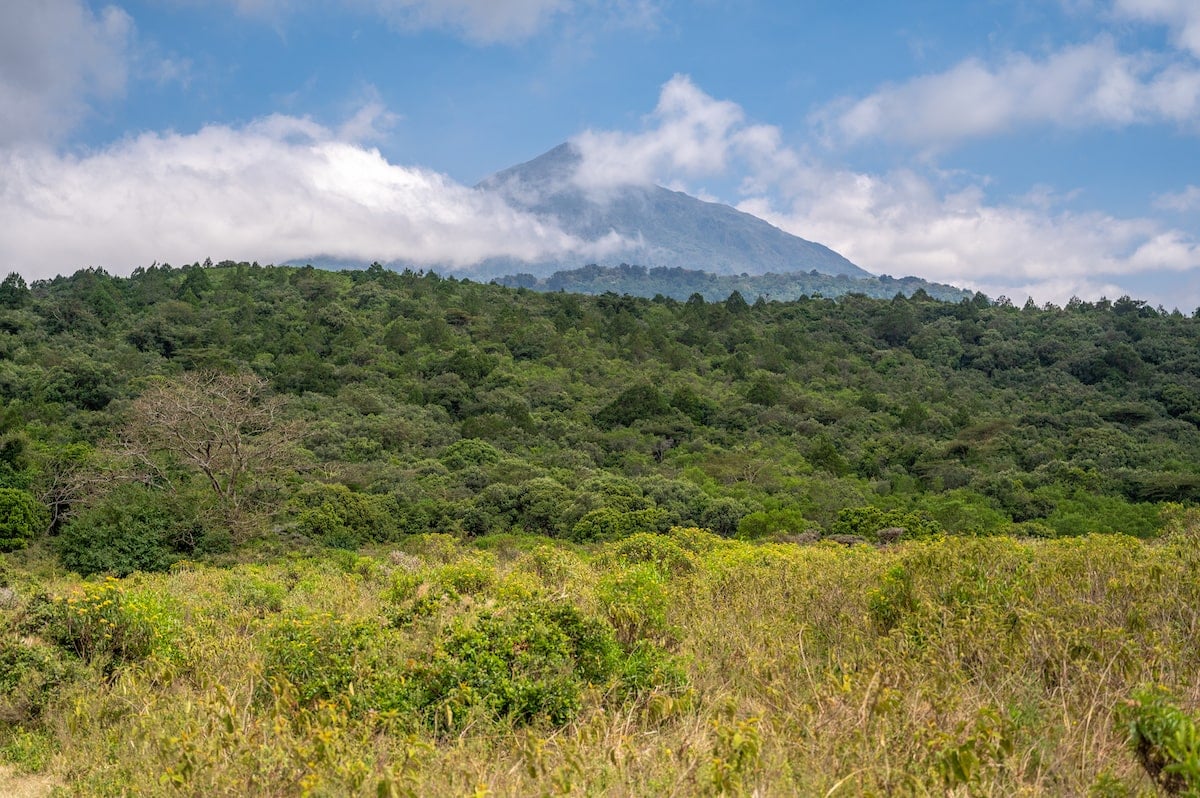
 Arusha National Park’s entrance fees for non-East African residents are $45-50 for adults (depending on the season) and $15 for children aged 5-15. You must be accompanied by an armed ranger if hiking in the park, which costs extra depending on how many hours you want to walk.
Arusha National Park’s entrance fees for non-East African residents are $45-50 for adults (depending on the season) and $15 for children aged 5-15. You must be accompanied by an armed ranger if hiking in the park, which costs extra depending on how many hours you want to walk.
Arusha National Park is popular for game drives—especially for tourists with limited time who can’t travel all the way to the Serengeti—so keep your eyes peeled for wildlife. Along the way, we see blue monkeys, cranes, zebras, and giraffes eating from acacia trees.
One highlight is seeing two giraffes twisting their necks and rubbing heads. According to Bosco, they were seeing if they might be suitable mates.
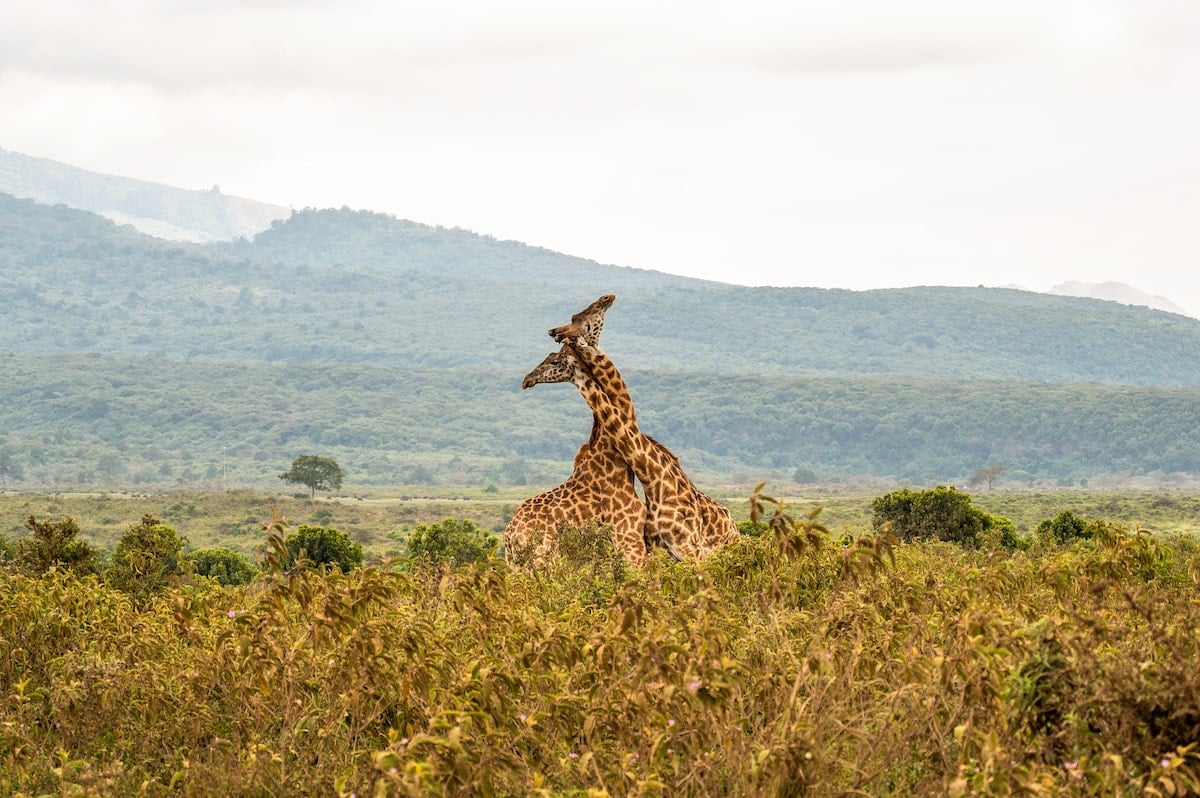
It takes about an hour to reach Momella Gate. Here we link up with our ranger, Roki, who shares interesting facts about the wildlife as we walk a flat and scenic path spotting buffalo, giraffe, and warthogs along the way.
The walk ends at the gushing Tululusia Waterfall, which is when we link up with a new ranger, Mwa, who takes us on a 5-hour round-trip hike up part of the famous Mount Meru.
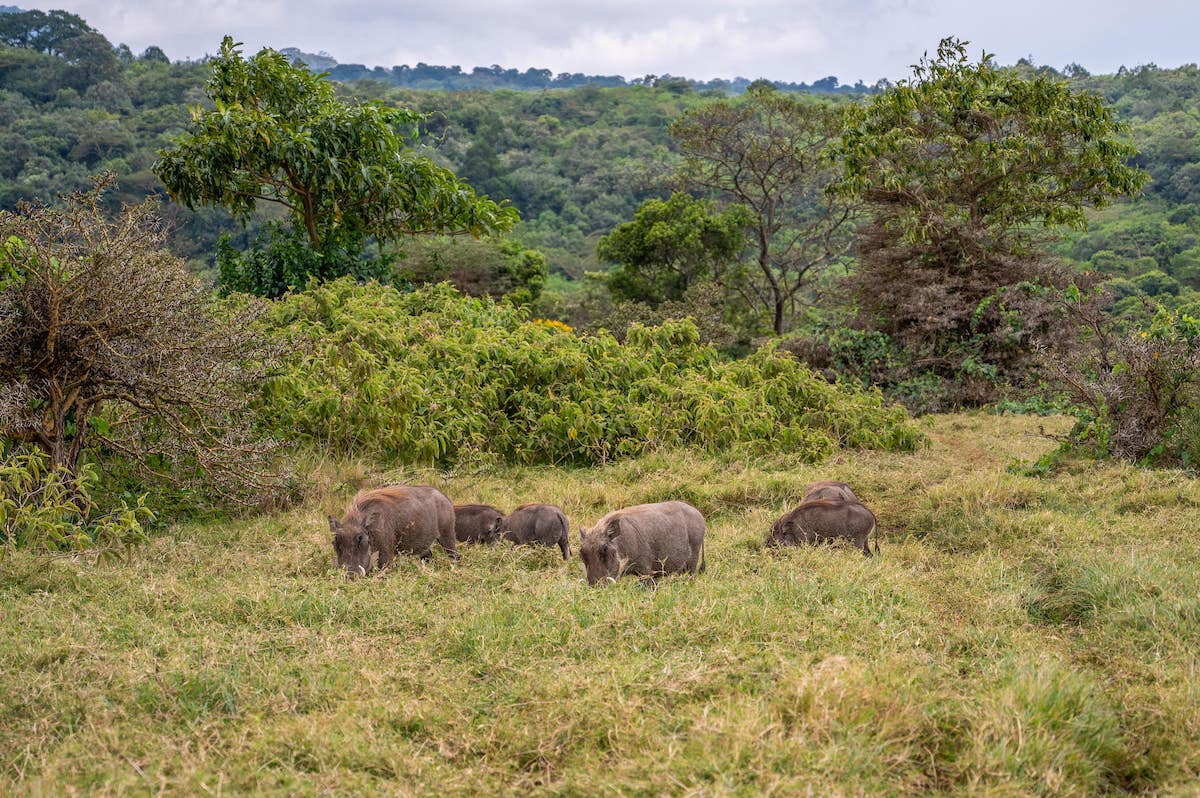
We trek up to about 2,000 meters, taking in views of Mount Meru, Little Meru, and the Momella Lakes as well as hiking through giant flower fields, moss-draped forest, and the famous Fig Tree Arch.
The real highlight though is the wildlife. Along with the animals previously mentioned, we spot baboons, blue monkeys, black-and-white colobuses, and antelopes—and even unique insects like giant flying grasshoppers!
 Tip: If you want a shorter or easier hike, just let your ranger know so they can create a different route for you.
Tip: If you want a shorter or easier hike, just let your ranger know so they can create a different route for you.
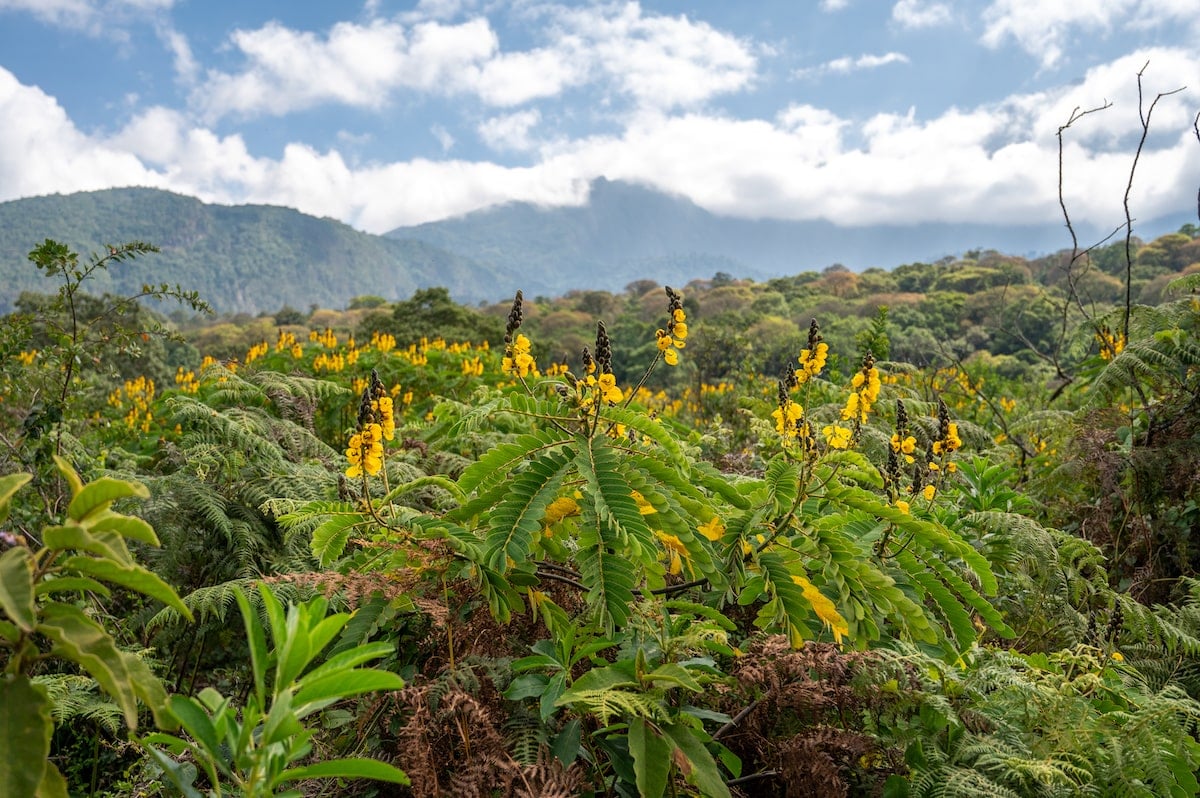
Back at the Gran Meliá Arusha, a dip in the pool followed by a rooftop cocktail with a Mount Meru view and a buffet dinner paired with South African cabernets under the stars is the perfect way to end the day.
Serengeti National Park
Length: 2 nights
Distance: It takes about 8 hours to reach Lahia Tented Lodge in Serengeti National Park’s Western Corridor from Arusha
Accommodation: Lahia Tented Lodge, an all-inclusive rustic luxe lodge right in the Serengeti. Spot wildlife right from your lodge balcony or their infinity pool, enjoy sudsing up under the moonlight in an outdoor shower, and eat delicious meals in their open-air restaurant.
Tours: Click here for Serengeti National Park tours
Day 5: Visit a Maasai Village & see wildlife in Serengeti National Park
Today, you’ll switch to a 4×4 vehicle with a pop-up top for the safari portion of your Tanzania itinerary.
The drive toward Serengeti National Park is interesting, as you pass Maasai villages with people herding livestock as well as red brick homes built by the Iraqw people.
After a brief stop at the Safariland Gallery for a bathroom break, it’s a bit farther until we reach the entrance to Ngorongoro Conservation Area, which you pass through to reach Serengeti National Park.
This is when the road becomes extremely bumpy and you’ll get a “free African massage”. Make sure all of your belongings are secured from here on out or they’ll be bouncing around like crazy!
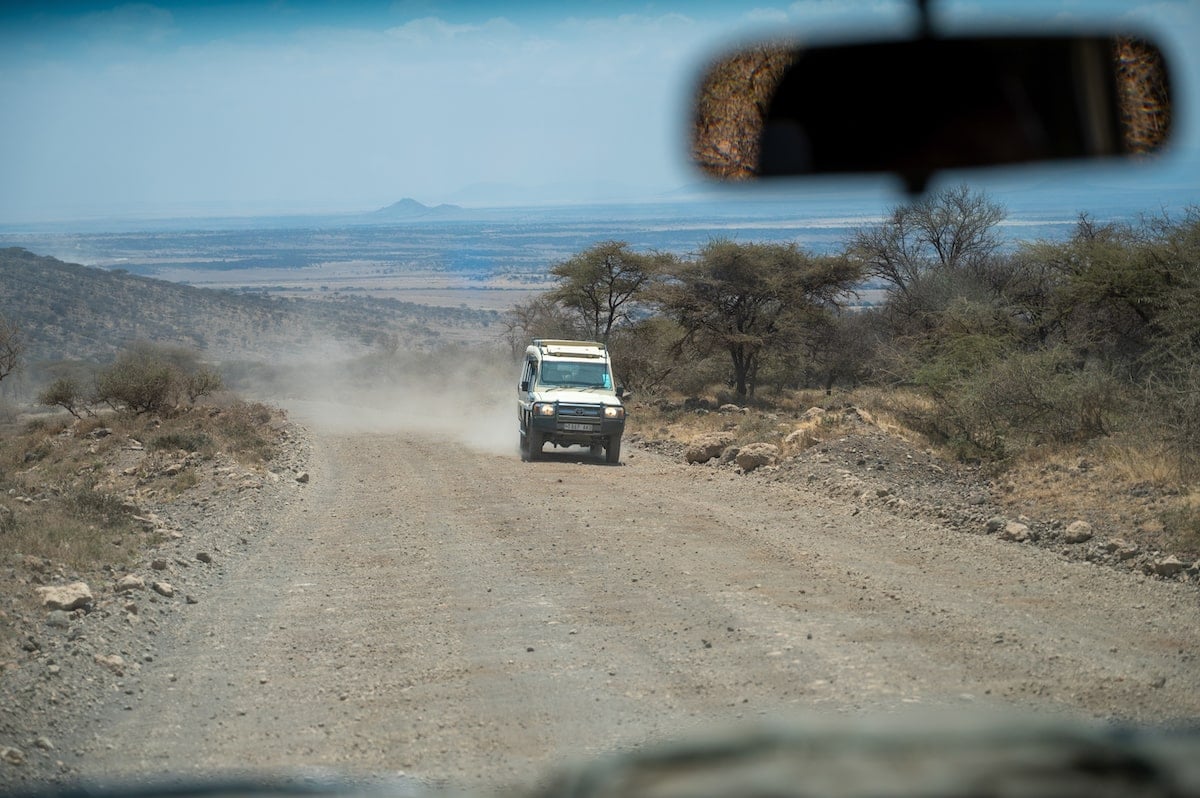
While today is more about getting to your Serengeti accommodation than doing a proper game drive, you can do a Maasai Village visit along the way.
The Maasai are a semi-nomadic ethnic group primarily residing in Tanzania and Kenya. Despite modernization, they’ve retained their traditional pastoral way of life, distinct cultural heritage, and colorful shúkà cloth attire.
Our guide, whose name I hear as Beckory, is the chief’s son. Walking with him into the village, we’re greeted with a welcome song and dance before watching—and taking part in—”adumu” or “jumping dance,” which involves rhythmic shoulder movements and jumps that show off a person’s strength.
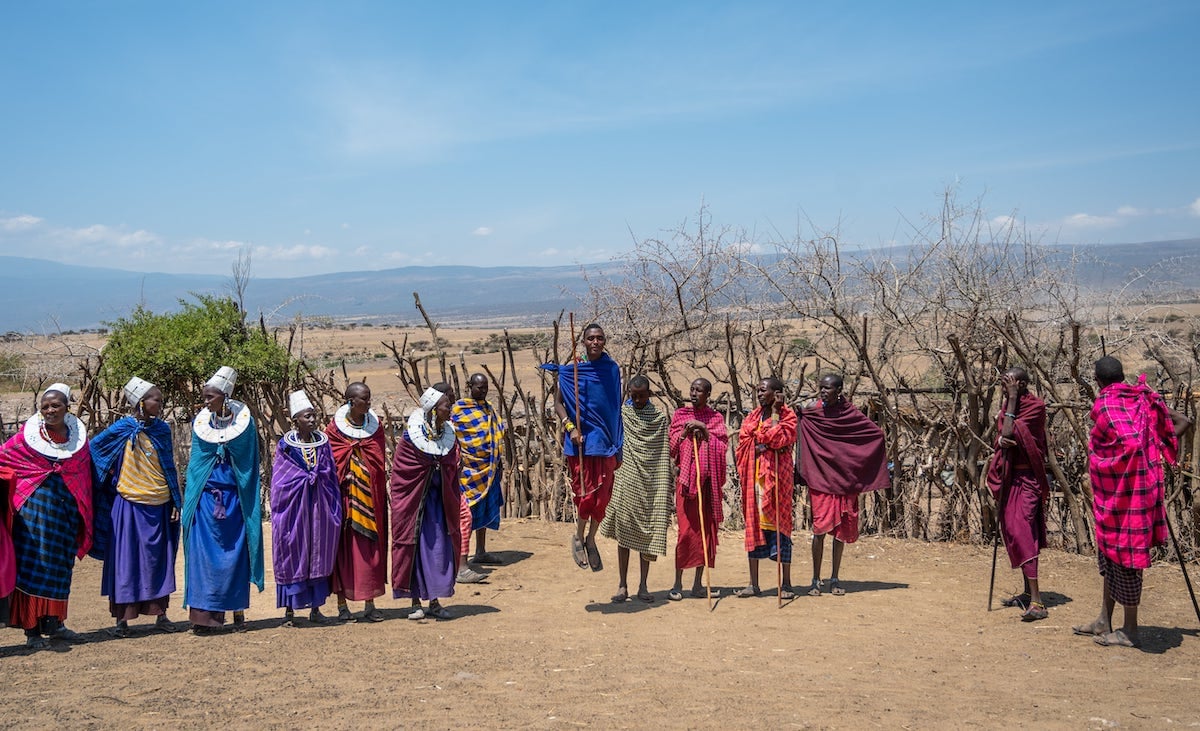
“Maasai jump high because we drink cow’s blood,” he explains, referring to how the Maasai drink cow’s blood mixed with milk, particularly during ceremonies.
Afterward, we learn more about village life, visiting a kindergarten class in an outdoor classroom before going inside a Maasai hut.
The small huts—which take 3 weeks to build and last about 6 years—are made of sticks, mud, grass, and cow dung to provide insulation. Inside, there are two small beds made from cow skin and a small mud stove built into the ground. We sit on the beds while Beckory shares more about Maasai life and invites us to ask questions.
Finally, we peruse the handicraft tables showcasing beaded ornaments, coasters, and bracelets that we’re told are made by the Maasai women, with wood-carved masks and statues being made by the men.
 Note: these handicrafts will be very pricey compared to what you’d pay elsewhere in Tanzania, but you can haggle. Plus, half of what you pay goes to helping them purchase water and half goes to supporting their village.
Note: these handicrafts will be very pricey compared to what you’d pay elsewhere in Tanzania, but you can haggle. Plus, half of what you pay goes to helping them purchase water and half goes to supporting their village.
From here, continue on the bumpy road and through the gate of the famous Serengeti National Park. For the best safari in Tanzania, make sure to visit this amazing location!
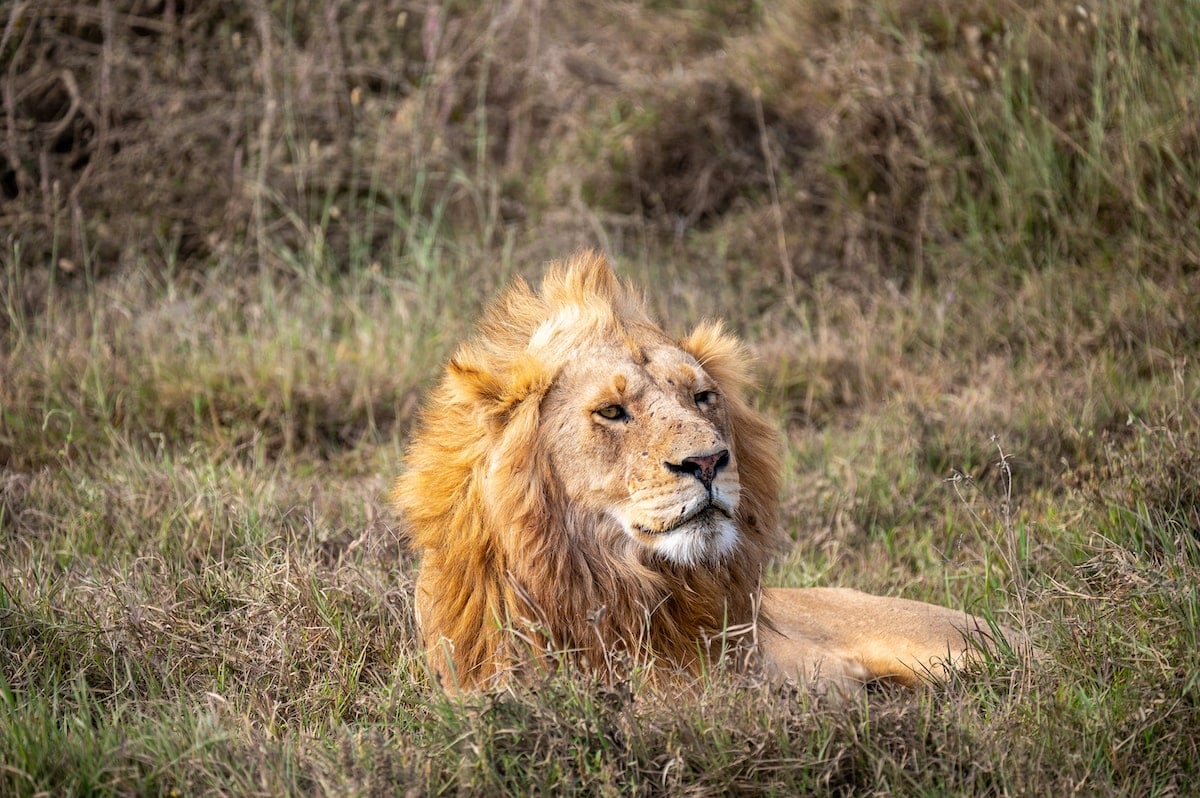
From here it’s still a few hours to Lahia Tented Lodge, so our safari guide, Godfrey, drives fast.
During the drive, we see wildlife almost every minute: brother lions lounging in the grass, a family of elephants eating along the treeline, zebras and wildebeests sprinting in front of the sunset, and so much more.
 Fun fact: zebras and wildebeests, along with the gazelles, work together. While zebras have a great memory, wildebeests have a strong sense of smell and the gazelles feed on the remaining grass to allow fresh grass to grow. Zebras also like to stand in a way that lets them literally watch each others’ backs.
Fun fact: zebras and wildebeests, along with the gazelles, work together. While zebras have a great memory, wildebeests have a strong sense of smell and the gazelles feed on the remaining grass to allow fresh grass to grow. Zebras also like to stand in a way that lets them literally watch each others’ backs.
Once at Lahia Tented Lodge, an all-inclusive meal—with wine—in their open-air restaurant is the perfect way to end the day.
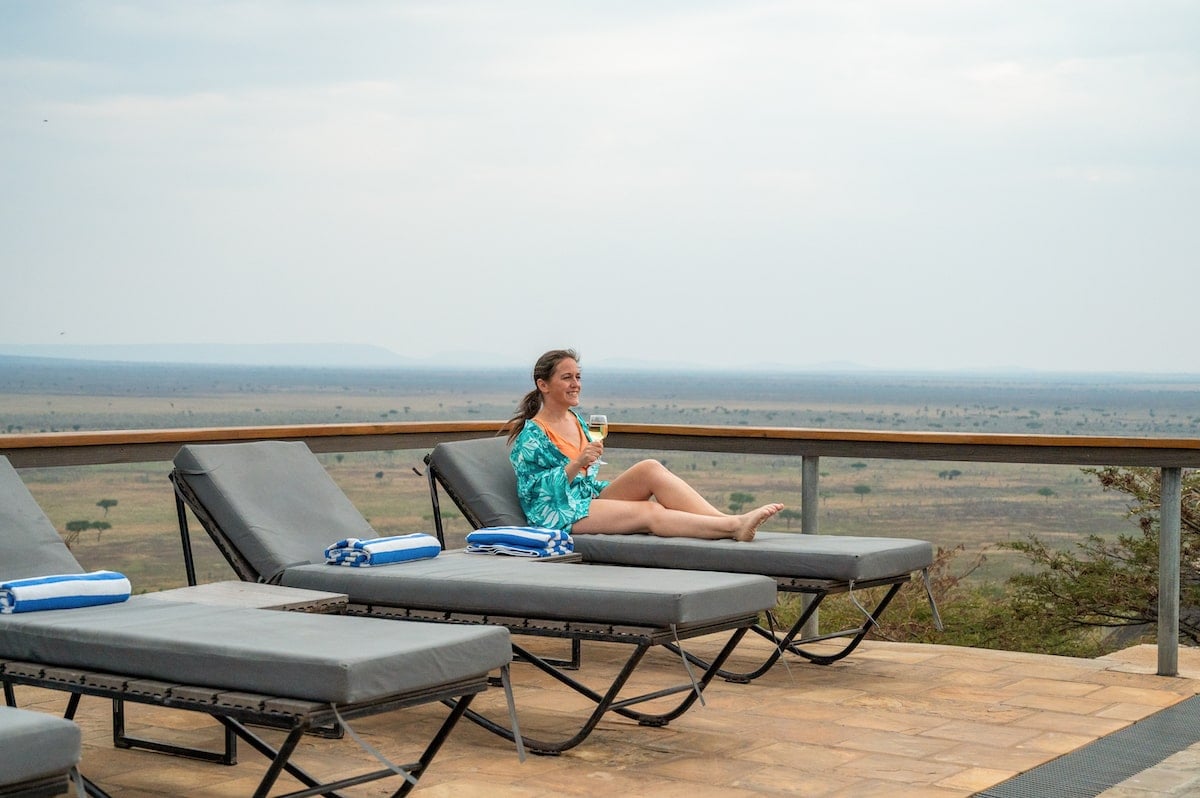
Day 6) Do a sunrise hot air balloon safari over the Serengeti followed by a game drive
A Serengeti hot air balloon safari is a magical experience. Yes, the pickup time is very early; but, you’ll be able to wake up with nature around you and watch the sunrise over the national park.
Floating over grasslands, acacia trees, and rolling hills, we see all kinds of wildlife: giraffe, elephants, zebras, hippos, gazelles, ostriches, and more.
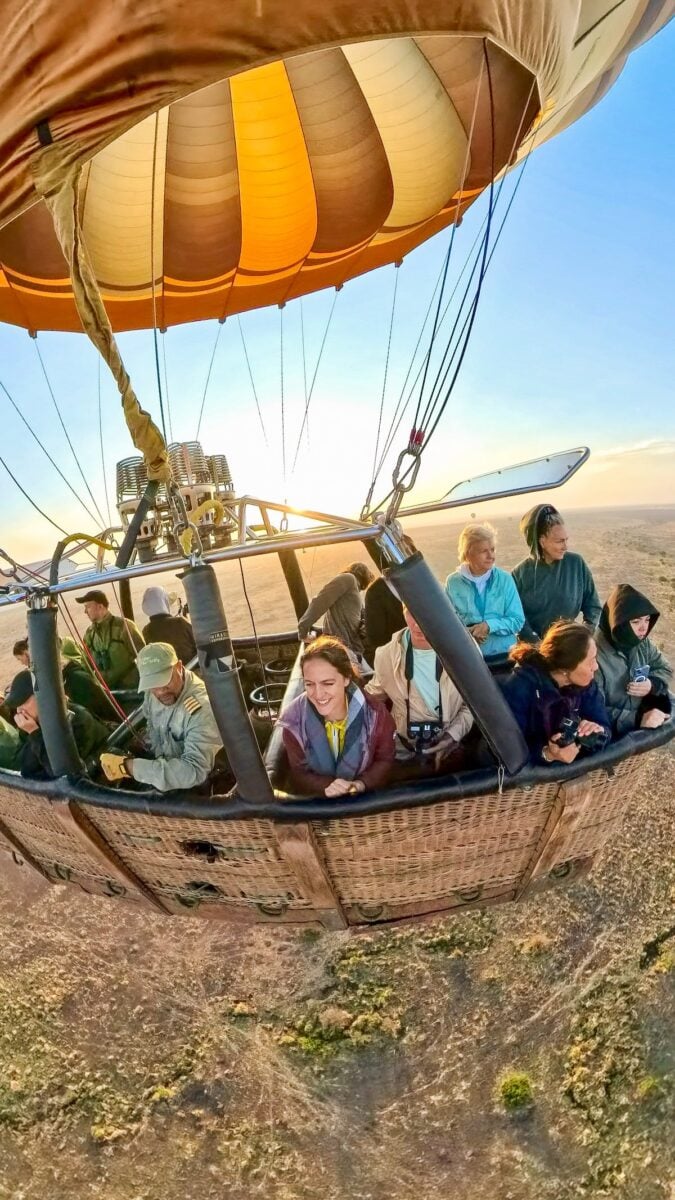
After the hot air balloon ride, there is also an alcohol-free sparkling wine toast and breakfast.
This trip to Tanzania is a postponed honeymoon for Andy and I. As a sweet surprise, the staff baked us—along with other guests celebrating milestones and special events—a cake and sang a celebratory song in Swahili.
Still riding high from our morning, we set out on an afternoon game drive through the Serengeti. Almost immediately, we’re spotting lions, cheetahs, hyenas, baboons, gazelles, giraffes, zebras, warthogs, ostriches, banded mongoose, and even a Nile crocodile.
The main highlight of the day was finding a pool with over 50 wading hippos before a family of about 15 elephants emerged from the forest to drink and splash themselves with water to cool themselves down using their trunks.
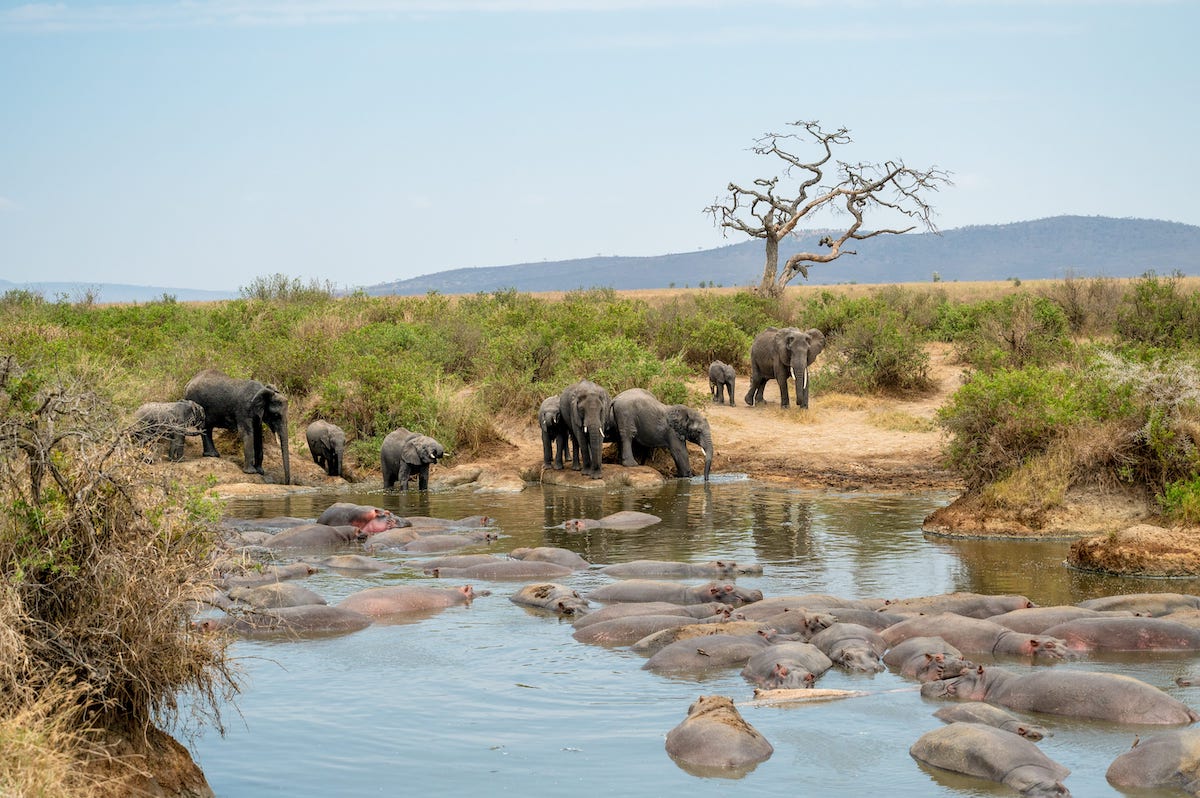
It’s incredible to see these animals in their natural habitat. These moments are one of the main things that make Tanzania such an incredible destination.
 (Not So) Fun Fact: despite being herbivores, hippopotamuses kill the most people in Africa as they are highly territorial and aggressive, especially in and around waterways. Luckily, we were in a safari vehicle!
(Not So) Fun Fact: despite being herbivores, hippopotamuses kill the most people in Africa as they are highly territorial and aggressive, especially in and around waterways. Luckily, we were in a safari vehicle!
Ngorongoro Conversation Area
Length: 3 nights (you’ll stay at the same lodge for Tarangire National Park & Lake Manyara too)
Distance: From Lahia Tented Lodge, it takes about 4 hours to reach Ngorongoro Crater. From there, it’s about 3 more hours to reach Maramboi Tented Lodge.
Accommodation: Maramboi Tented Lodge, an all-inclusive rustic luxe lodge near Tarangire and Lake Manyara National Parks. Sit on your deck or at their infinity pool and watch wildlife from the property, enjoy amazing al fresco meals, and sip wine at their poolside happy hour while watching the sunset over Lake Manyara.
Tours: Click here for Ngorongoro Crater tours
Day 7) Do a game drive in Ngorongoro Crater
No Tanzania safari itinerary would be complete without mentioning the Ngorongoro Conservation Area. Today you’ll check out of Lahia Tented Lodge and head there for a game drive—but not before driving through more of the Serengeti to reach your destination.
Leave early to increase your chances of seeing wildlife, as animals often hide from the midday sun. We left at 7am, and immediately saw loads of giraffes, elephants, buffalos, baboons, and more.
The most interesting sighting was a pair of lions lying in the grass next to a fresh zebra carcass, with jackals and hyenas waiting nearby to get their turn to feed on the remains. Further down the Western Corridor, a full pride of female lions and cubs were lying in the grass and drinking from a pond.
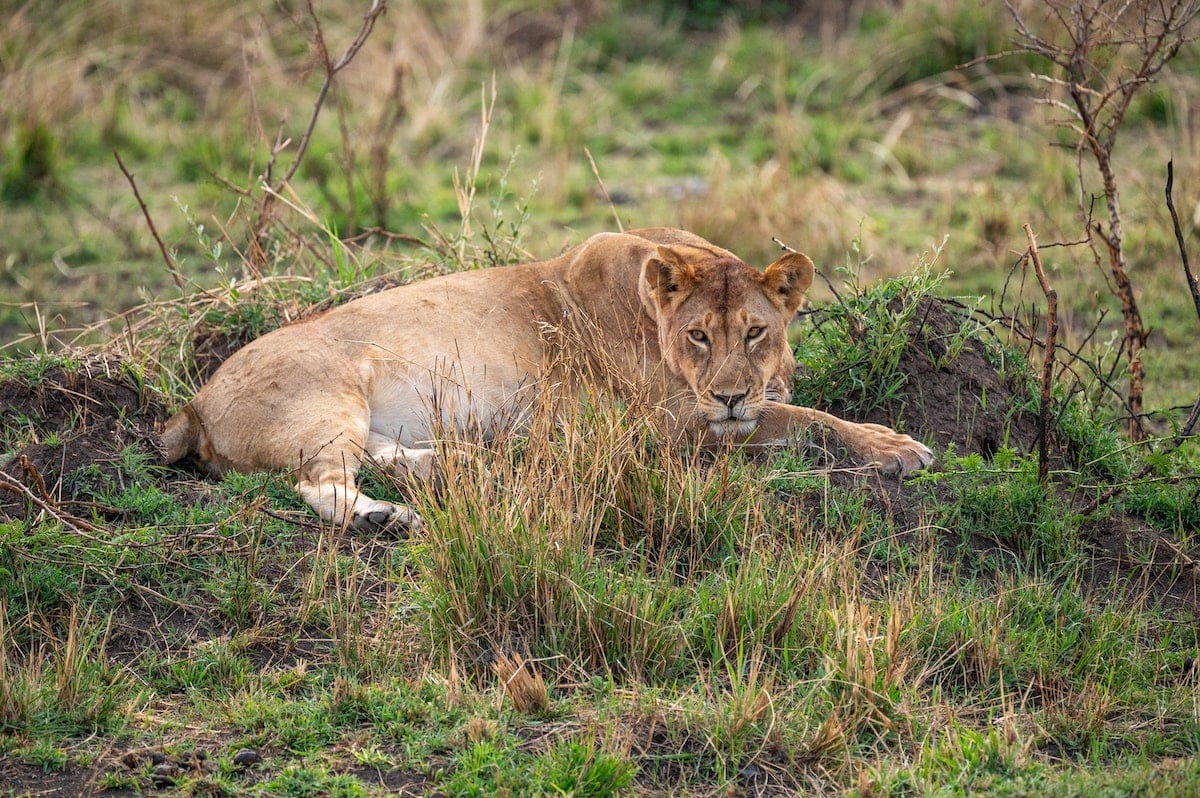
It takes about 4 hours to reach Ngorongoro Conservation Area, home to the world’s largest inactive and intact volcanic caldera, Ngorongoro Crater.
Here cultural heritage meets natural beauty, as it’s home to the Maasai people as well as diverse wildlife—including the Big 5! There are also a variety of habitats and ecosystems: swamps, fresh and saltwater lakes, wetlands, savannahs, and more.
After passing “Giraffe Country”—a high forested area toward the top of the crater where loads of giraffes graze since they can’t make it down its steep hill—you’ll descend into the crater, which is teeming with wildlife.
A few highlights during my game drive include seeing zebras left behind during the Great Migration crossing a river, lions chasing warthogs (they got away!), and even a black rhino in the distance!
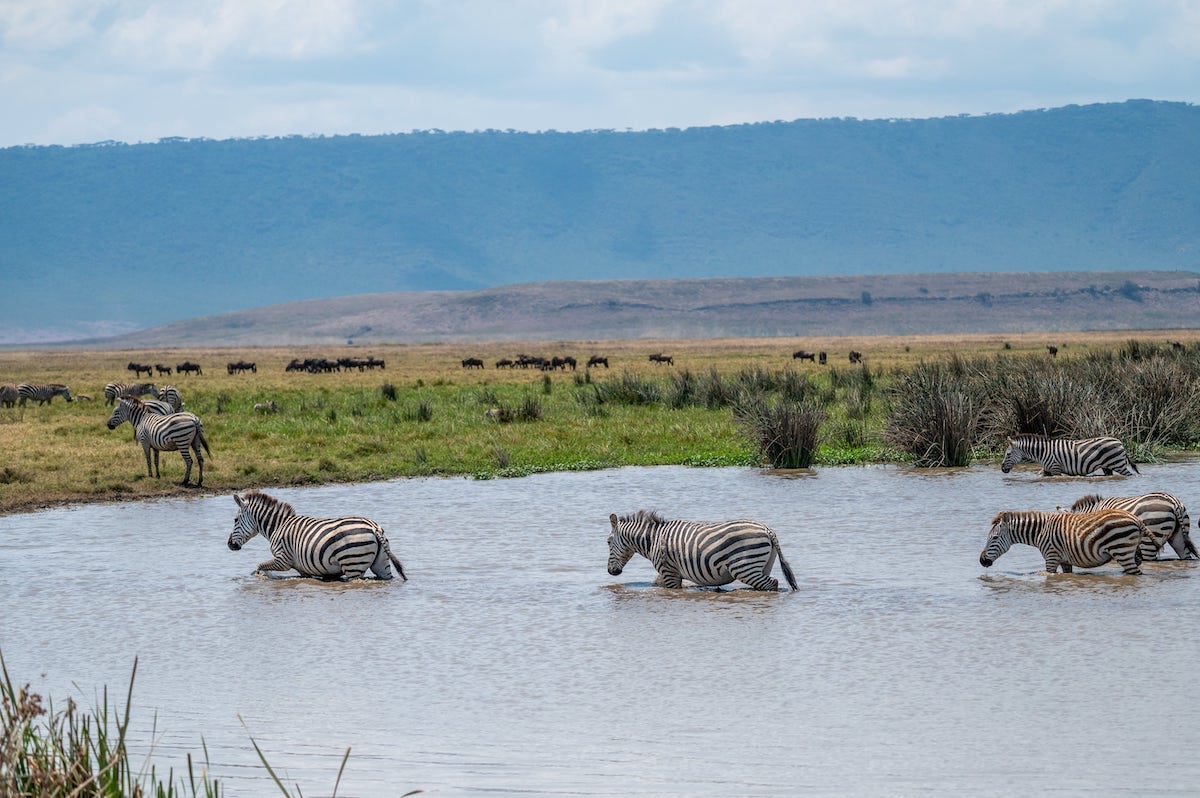
When it’s time for lunch, stop at the Ngoitok Picnic Site, where tables sit at the edge of a natural pool backed by rolling hills and filled with hippos and birds. It’s quite the idyllic place to enjoy your lunch box.
Once you’re done for the day, make your way to Maramboi Tented Lodge—but not before stopping at the Ngorongoro Crater Viewpoint for a beautiful view over the crater.
As you get closer to Maramboi, which sits near the shores of Lake Manyara, the endless acacia trees you’ve been seeing up until now become wild palms for a new type of natural beauty.
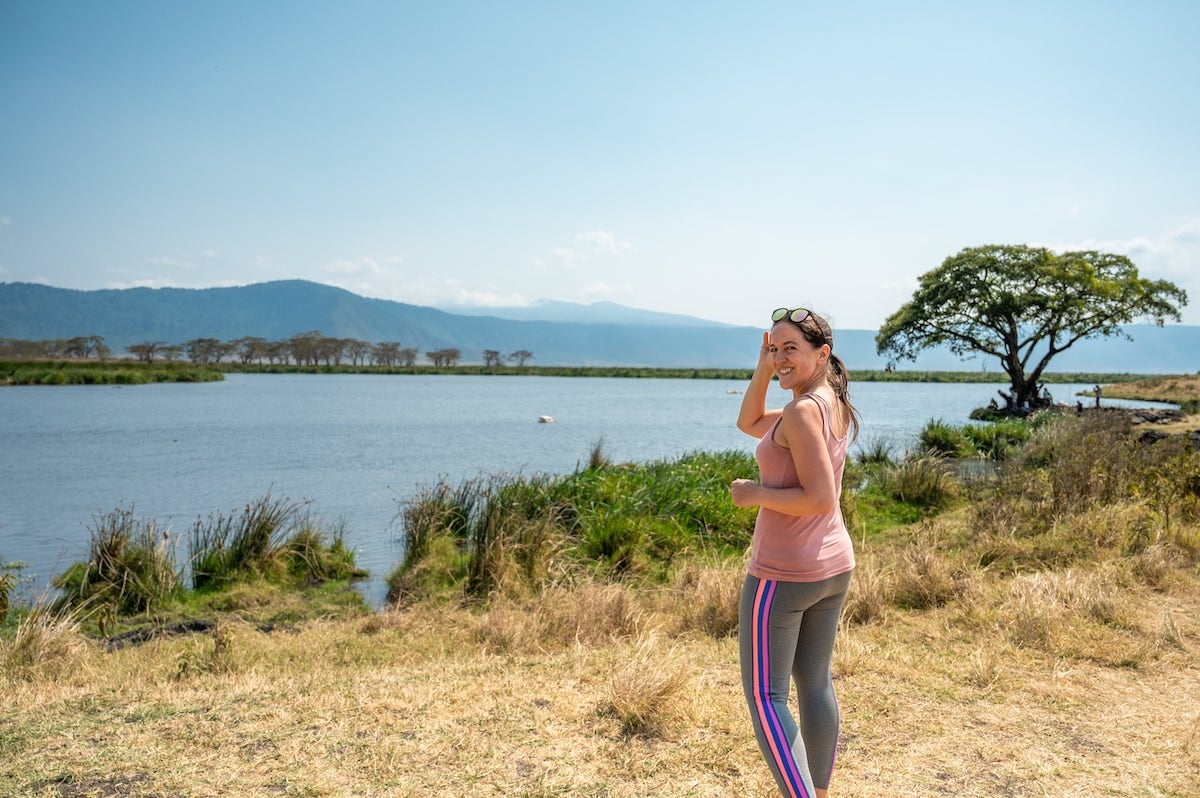
Tarangire National Park & Lake Manyara
Accommodation: You’re still staying at Maramboi Tented Lodge for this section of the trip
Tours: Click here for Tarangire National Park tours and click here for Lake Manyara tours
8) Explore local life in Mdori Village & have a pool day
While much of this 2-week Tanzania itinerary has involved waking up early and being on the go, today you’ll get to relax a bit.
After a leisurely breakfast on Maramboi’s outdoor deck, head to the nearby Mdori Village for a cultural tour.
Here we meet Flora, who gives us a tour of Mdori and tells us (through Godfrey, who translates) more about the area and the work of the women’s cooperative she is a part of.
During the tour, Flora will show you how to weave palm leaves into mats, baskets, hot plates, bowls, and more. You can also buy some of her amazing creations!
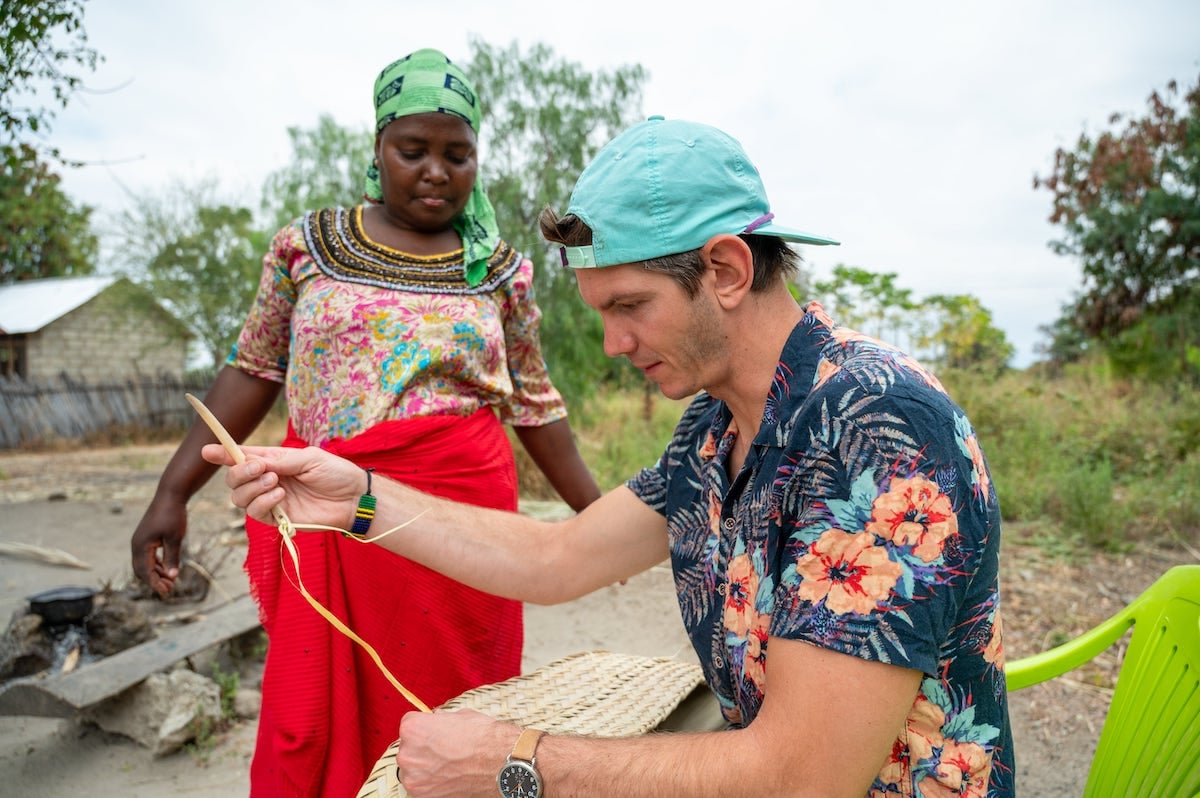
She’ll also take you to Lake Manyara to visit a seasonal fishing camp and see how locals fish for tilapia and catfish. While local men fish and women clean the fresh catch, storks sit on wooden canoes waiting for their piece of the fish pie.
Finally, we visit a local school and pop into a few of the classes. The kids are excited to see us, and many hold our hands and practice their English with us. Andy is a teacher back in New York, and it’s fun for him to see how the school is run and also do a little guest lesson on animal names.
The tour is not only an interesting way to learn about local culture, but also support the women’s cooperative and the local community.
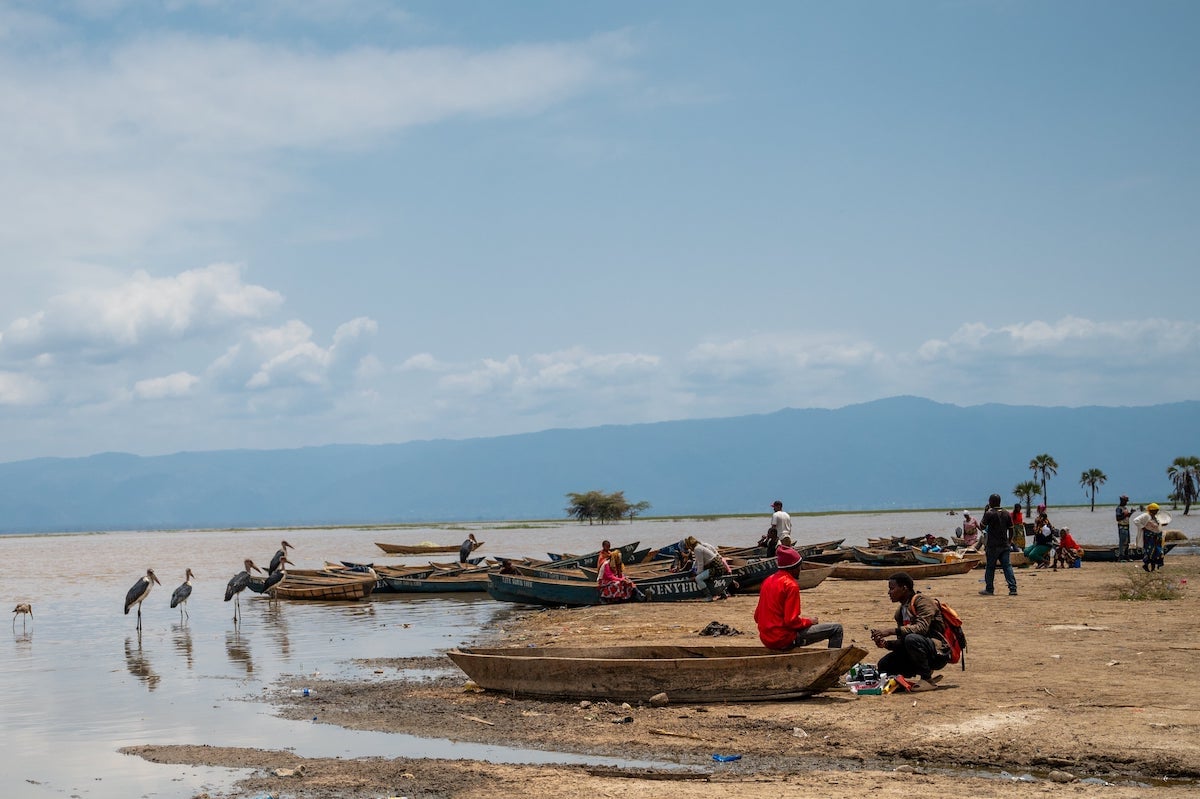
Afterward, spend the rest of the day at Maramboi Tented Lodge eating a delicious lunch, lounging by the pool, and sipping sundowners.
During my time at the lodge, Chef Praygod made me a special meal since I don’t eat meat. It was one of the best I had on the trip—and I got to try ugali, a popular local dish similar to polenta that’s often referred to as the national dish of Tanzania.
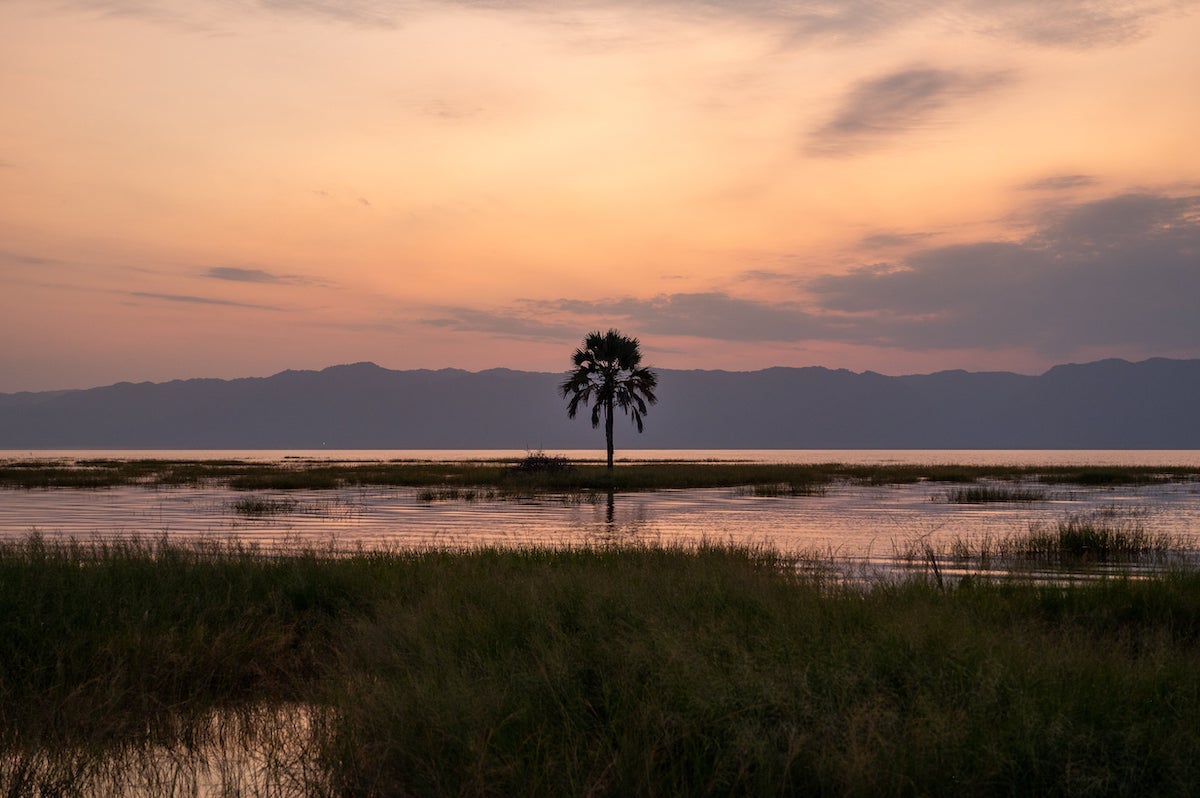
Day 9) Do a safari drive of Tarangire National Park
Encompassing 1,100 square miles, Tarangire National Park is renowned for its vast elephant herds, enormous baobab trees, and over 500 species of birds.
I can vouch for the giant elephant herds, as we see so many during our time in the park—along with zebras, giraffes, warthogs, common waterbucks, elanders, ostriches, wildebeests, reedbuck antelopes, impalas, and more.
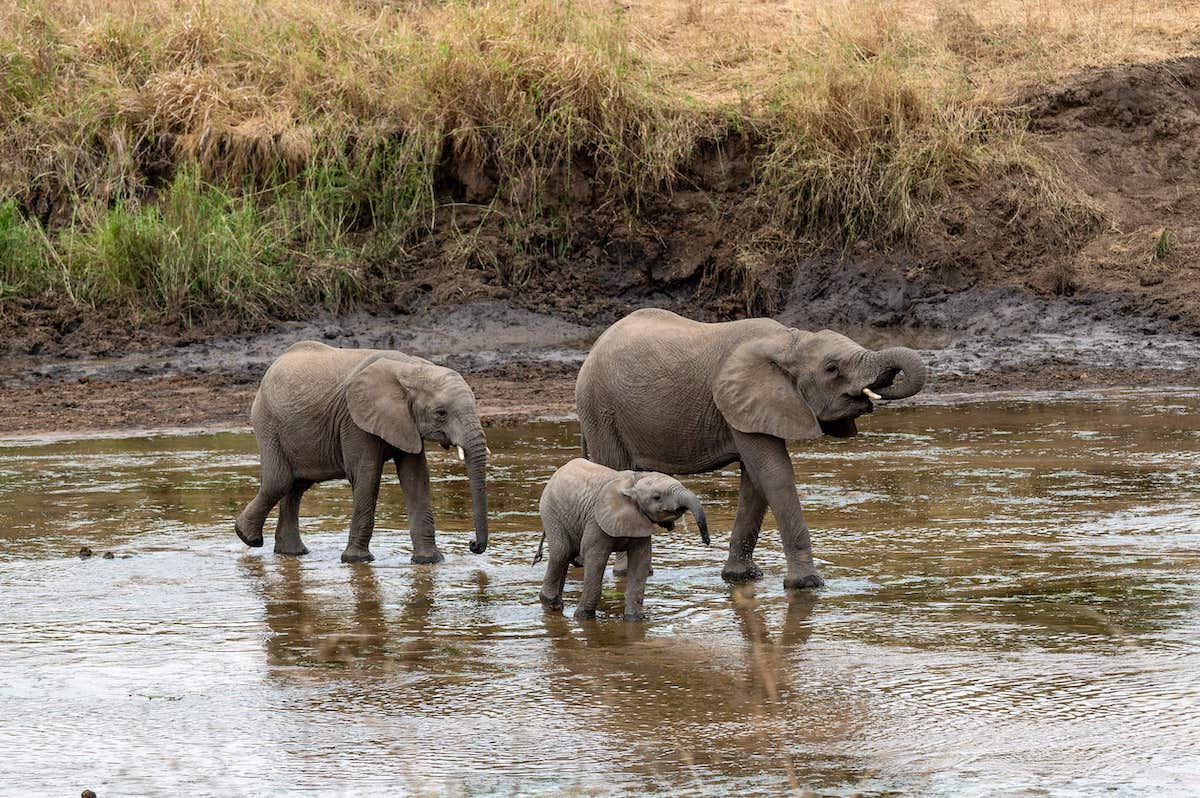
Along with seeing brother cheetahs lying in the grass, another highlight is watching multiple baboon troupes in the wild. I could watch them climbing trees and eating fruit all day!
Make sure to keep your eyes peeled for leopards, which the park is also known for. While we didn’t end up seeing any, it just gives us a reason to return to Tanzania.
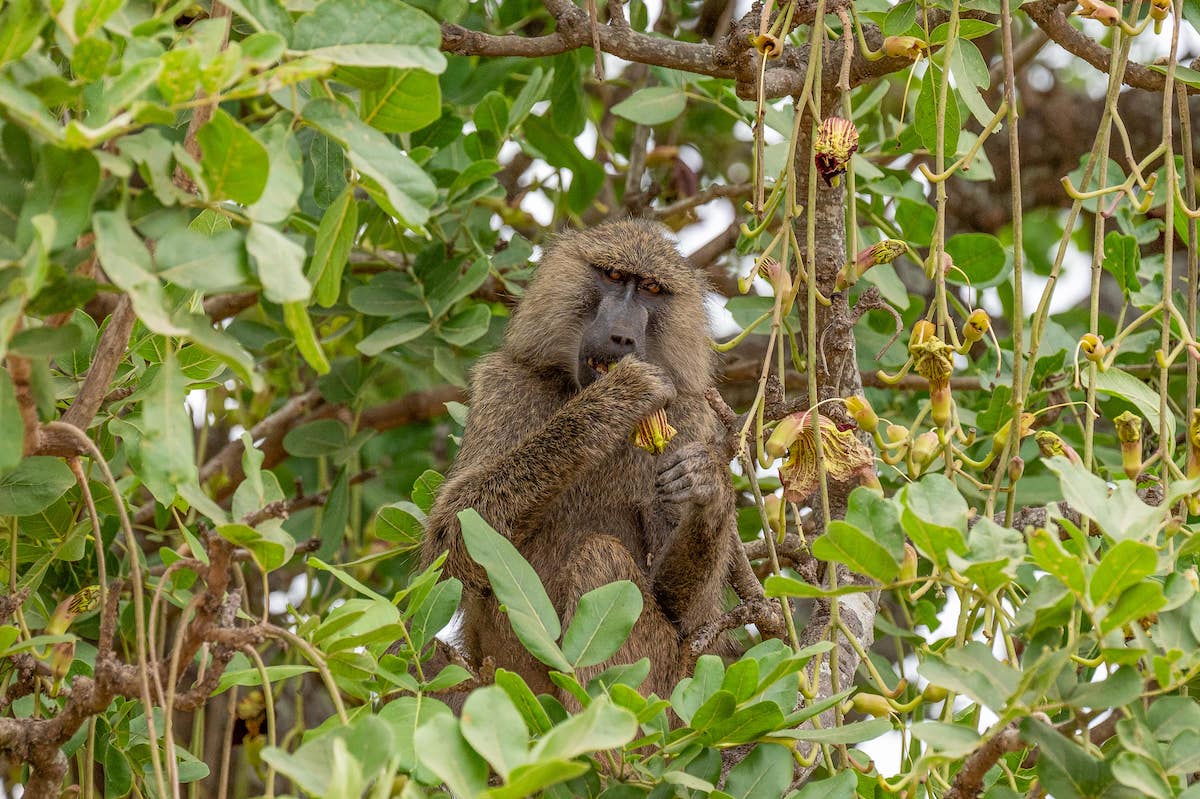
Zanzibar
Length: 4 nights
Distance: From Maramboi Tented Lodge, it’s about an hour and 45 minutes to Arusha Airport, where you’ll catch a 90-minute flight to Abeid Amani Karume International Airport in Zanzibar. From there, it’s a 1-hour drive to Kisiwa on the Beach.
Accommodation: Kisiwa on the Beach, a peaceful and luxurious all-villa accommodation right on quiet Paje Beach. They’ve got a pool, open-air restaurant and bar, a private slice of beach, a gym, and an amazing spa (I loved my massage!). You’ll also have your own waiter/waitress the entire time who will help make your stay extra perfect. Meeting our amazing waiter, Fahad, was a trip highlight!
Tours: Click here for tours of Zanzibar
Day 10) Shop for souvenirs & travel to Zanzibar
Going to Zanzibar after safari is the perfect way to relax after your adventure.
While today is essentially a travel day, I highly recommend leaving time to visit the Cultural Heritage Gallery & Shops—one of the largest galleries in Tanzania that has absolutely every souvenir you could want across multiple buildings.
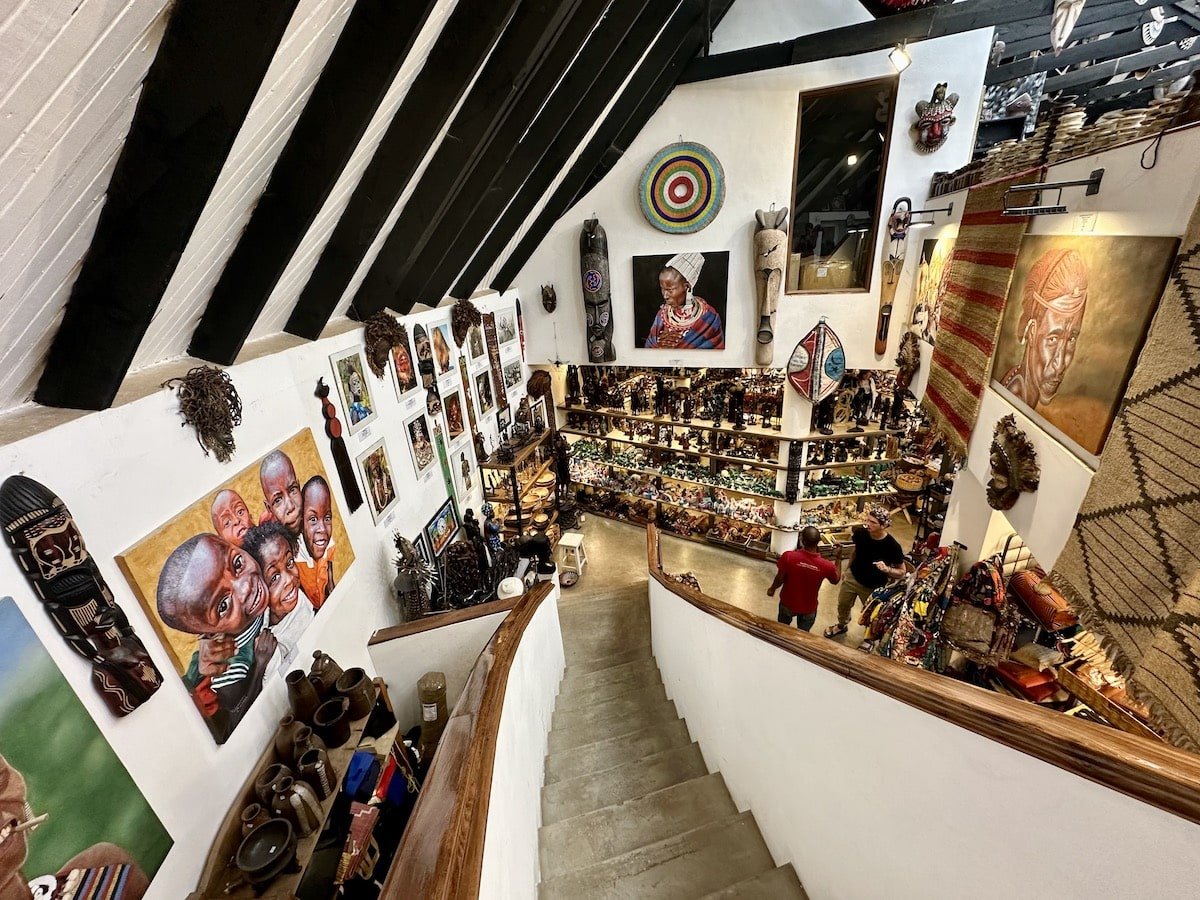
Paintings, statues, handmade jewelry and Tanzanite, housewares, masks, tribal art, and so much more can be found along with cultural demonstrations and live music.
The prices are also much cheaper than anywhere else we saw during our 2 weeks in Tanzania, and the location is super convenient right near Arusha Airport, so you can shop, eat lunch onsite, and then go.
 Tip: on the flight, try to sit on the left side of the plane (A and B seats on Precision Air) as you’ll get a great view of Mount Kilimanjaro poking up above the clouds!
Tip: on the flight, try to sit on the left side of the plane (A and B seats on Precision Air) as you’ll get a great view of Mount Kilimanjaro poking up above the clouds!
Day 11-14) Visit Stone Town & enjoy island life in Zanzibar
Your itinerary for Zanzibar—an archipelago in the Indian Ocean—can be as active or chill as you’d like it to be. After many early wake-up calls and long days of hiking, exploring local villages, and doing game drives, we wanted to mainly just lay on the beach, swim, and get massages.
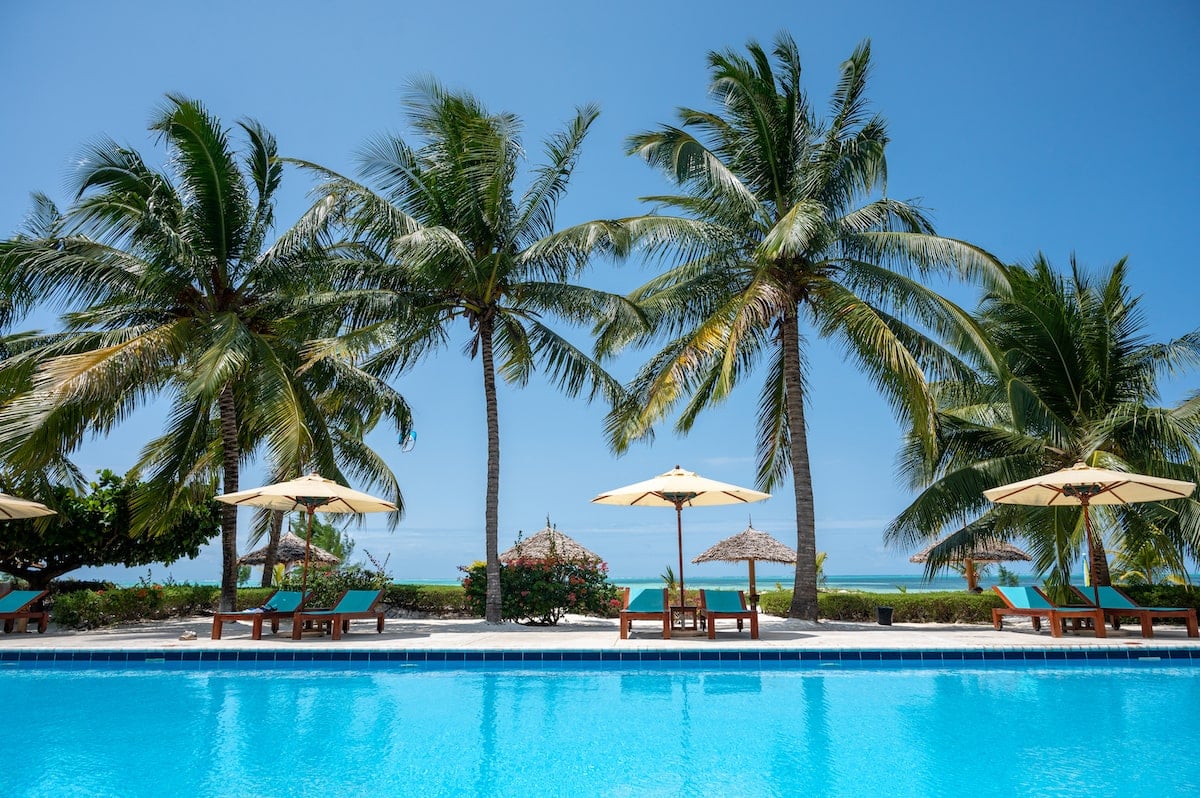
There are a few main beaches travelers typically opt for:
- Paje, a tranquil beach known for its soft sand and kitesurfing opportunities
- Nungwi, famous for its breathtaking sunsets and lively atmosphere, including nightlife and a bustling beachfront
- Kendwa, known for its wide, sandy beaches and safe swimmable waters unaffected by tides
Since we wanted something quiet, we opted for Paje Beach and were so happy we did. I loved walking the soft sand beach and watching the colorful kitesurfers doing tricks. The warm blue water was also perfect for swimming.
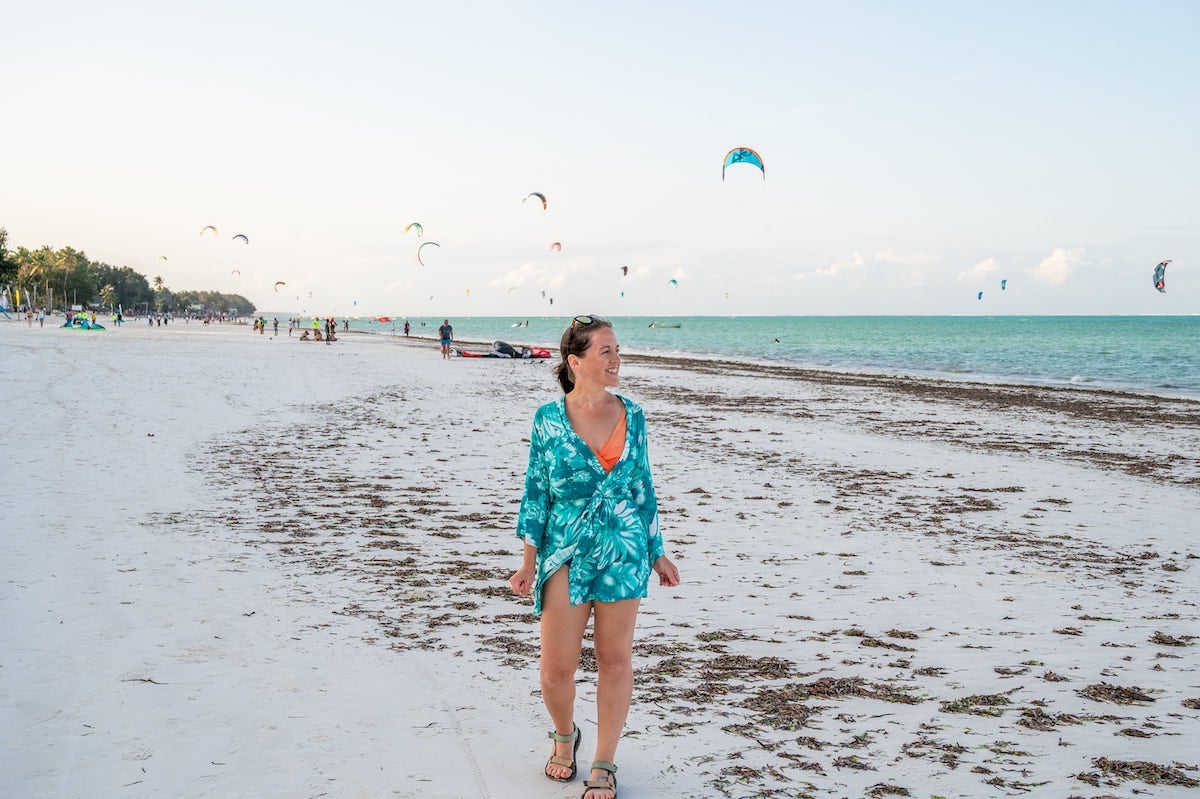
If you’d like to do an excursion, there are many guided Zanzibar tours, with a few top-rated options being the Explore Zanzibar’s Southeastern Charm Tour and a skydiving adventure.
 Tip: Read reviews (including the 1-star reviews) before booking tours in Zanzibar. When researching tours myself, I saw many bad reviews regarding negative impacts on wildlife at Mnemba Island (dolphins) and Prison Island (tortoises), though I didn’t go to these places myself.
Tip: Read reviews (including the 1-star reviews) before booking tours in Zanzibar. When researching tours myself, I saw many bad reviews regarding negative impacts on wildlife at Mnemba Island (dolphins) and Prison Island (tortoises), though I didn’t go to these places myself.
One excursion that should be on your Zanzibar travel itinerary is a walking tour of Stone Town, a UNESCO World Heritage Site and the historical center of Zanzibar. It’s known for its intricately carved wooden doors, winding streets, and diverse architecture showcasing African, Arab, and European influences.
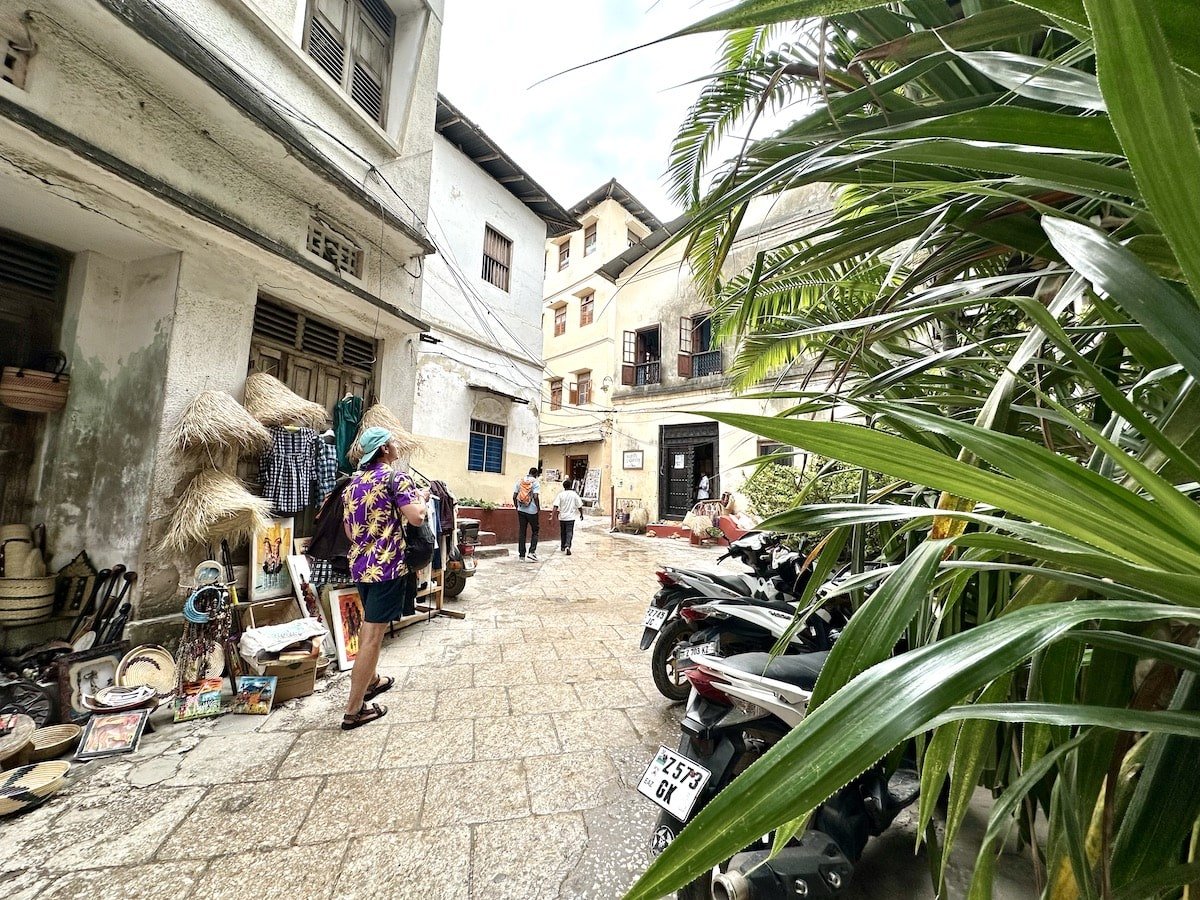
Stone Town is also home to important historic sites like the Sultan’s Palace, the Old Fort, and the somber but important Former Slave Market Site, which is also home to a memorial and museum. We spent over an hour here learning about this dark time in Zanzibar’s history (that sadly still goes on today around the world in the form of human trafficking).
If you’d like to shop, a few must-visit spots include Chako Shop for upcycled goods and Zanzibar Curio Shop for antiques. Across from the Emerson Spice Hotel, there are also a few little art shops, including one without a sign where a man sells his very beautiful banana leaf art.
When you’re hungry or want to enjoy a drink, there are several hotels with rooftop restaurants like the Africa House Hotel and Maru Maru.
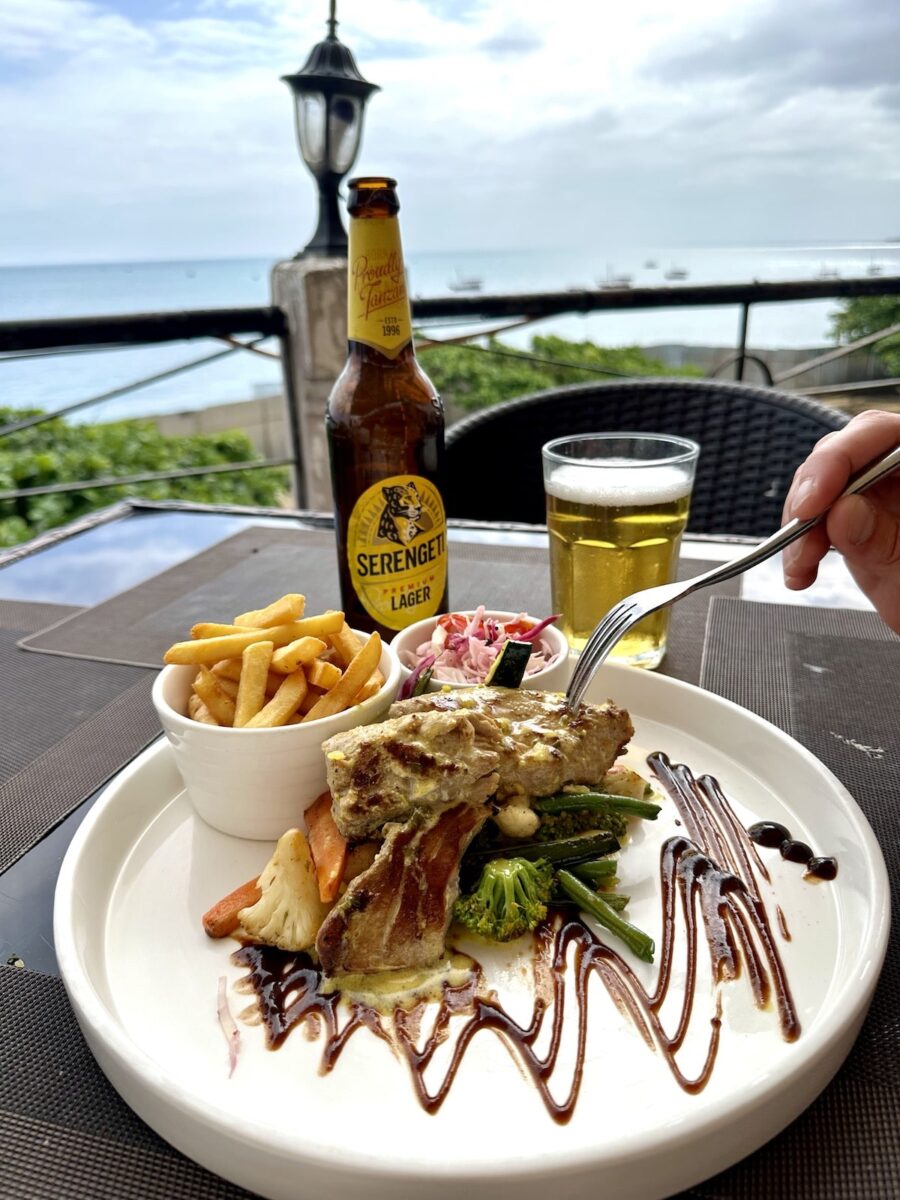
Shorter Tanzania Safari Itinerary Options
Don’t have 14 days to spend in Tanzania? While I suggest 2 weeks in Tanzania to really have a well-rounded trip, here are some options for shorter routes:
10 day Tanzania itinerary. If you only have 10 days in Tanzania, I’d recommend cutting out Moshi and Arusha. If you’re not into beaches, you can also keep those destinations and cut Zanzibar; but, in my opinion, keeping Zanzibar will allow for a more interesting and diverse Tanzania itinerary for 10 days.
7 day Tanzania itinerary. If you only have one week in Tanzania, I would focus 100% on the safari portion of the itinerary and visit Serengeti National Park, Ngorongoro Conservation Area, and Tarangire National Park. If Zanzibar is a must, you could also do Arusha National Park, Tarangire National Park, and Zanzibar (but stay in Stone Town at the top-rated Emerson Spice Hotel to be closer to the airport).
You might also opt to book a guided experience from Arusha like a 7-Day All-Inclusive Luxury Safari or a 7-Day Private Midrange Safari.

5 day Tanzania itinerary. With only 5 days in Tanzania, I’d recommend just going to Zanzibar or just doing Arusha National Park and Tarangire National Park. You can also maximize time by booking a guided experience from Arusha like:
5-Day Private Budget Safari with Tarangire, Serengeti, Ngorongoro Crater & Lake Manyara National Parks
5-Day Tarangire, Serengeti & Ngorongoro Crater Safari
5-Day Private Luxury Safari with Serengeti, Ngorongoro Crater & Tarangire National Park
Another idea is basing in Arusha and just doing day tours.
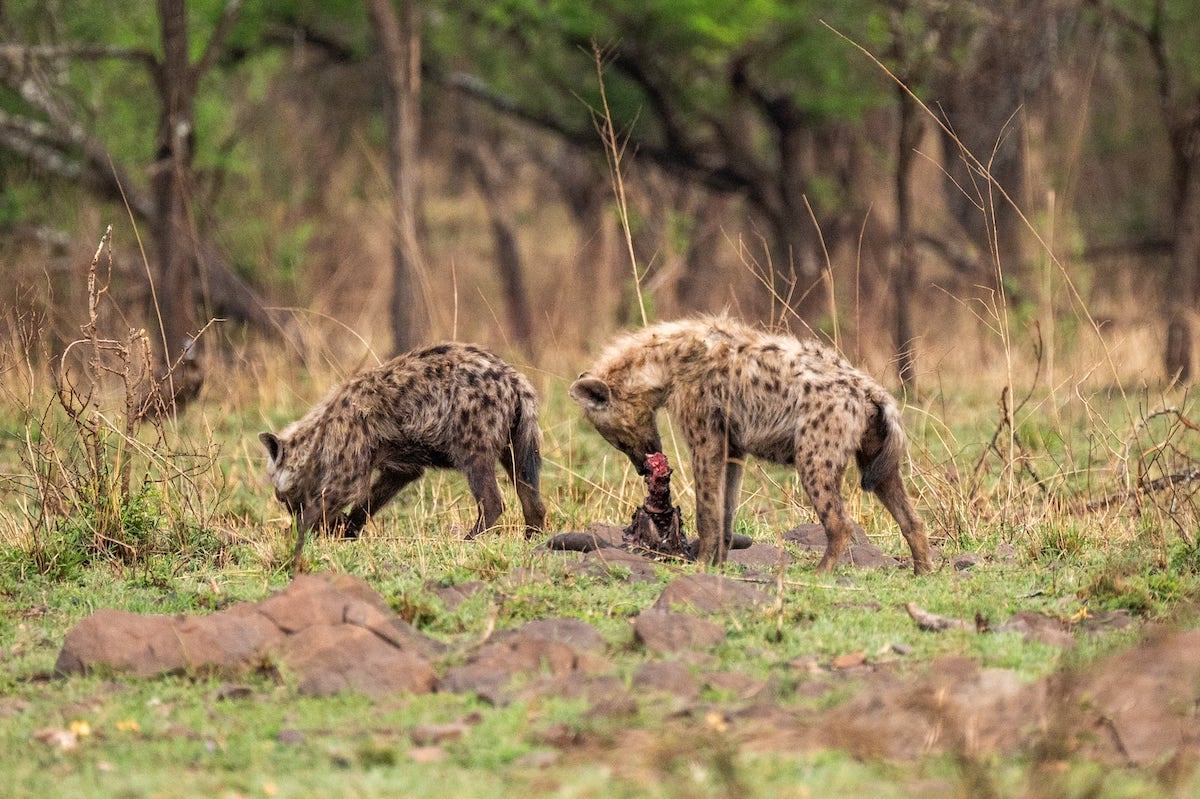
Tanzania Travel Tips
Now that you know where to go during your 2 weeks in Tanzania, let’s cover some important travel tips to keep in mind:
1) Get your visa before arriving in Tanzania. This will help you save time going through immigration. Click here to apply for a Tanzania visa. Personally, it took a week for my visa application to be processed, but give yourself additional time to be safe.
2) Tanzania’s national parks are very expensive. To save money, consider doing a budget safari in Tanzania. You might go camping—which is cheaper and incurs a much lower concession fee than safari lodges—or opt for less-visited parks with lower fees.
3) Cash is king. Even though we paid for our trip upfront, we still needed cash for tips, souvenirs, lunches in Zanzibar, and drinks at the hotels that weren’t all-inclusive. While you can also pay for things in USD (and locals seem to prefer it) I found that paying in cash with Tanzanian Shillings got a better rate.
If your trip is pre-booked and you just need cash for tips and a few extras, I recommend changing $200-$300 at the airport when you arrive. If you run out, you’ll be able to use the ATM again in Zanzibar.
4) Carry toilet paper and biodegradable bags. While most of the bathrooms we encountered were clean, there were some that didn’t have toilet paper or trash bins. Because of this, I found it helpful to always have a toilet paper roll on me and biodegradable bags (like these) to carry out the used paper to dispose of later.
5) You will want a telephoto lens. If you don’t own one, you can rent cameras and lenses from LensRentals.com, who make the experience of renting and returning gear easy. Having a telephoto lens gamifies being on safari as you try to capture the perfect shot and helps make it a more engaging experience.
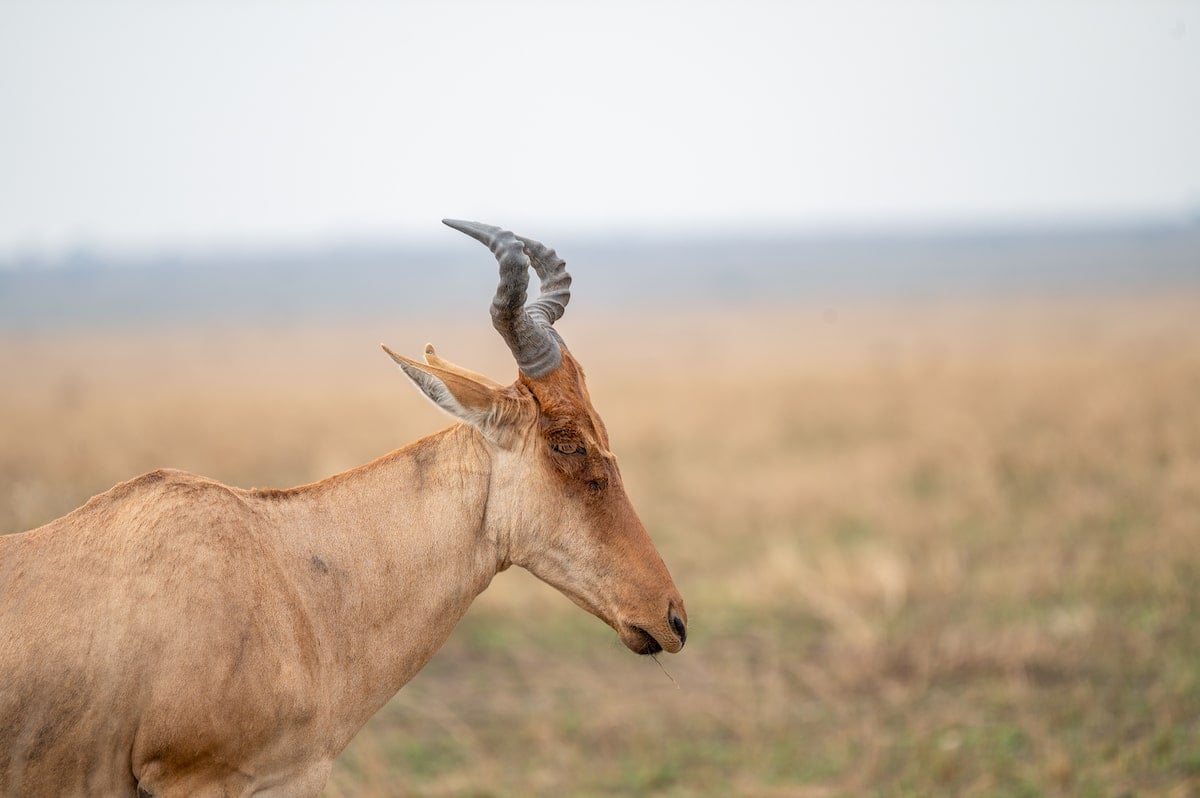
6) Safaris are DUSTY. You’ll be breathing this in, so pack a face mask and wear clothes you don’t mind getting dirty.
7) Pack clothing for all types of weather and situations. While I wore more trendy clothing at the lodges and hotels, I found it worthwhile to have a long skirt and multiple t-shirts for comfortable, cool, and conservative clothing for village visits and Stone Town in Zanzibar (which is much more conservative).
For game drives, I recommend layers in neutral light colors to stay cool and avoid insects. You don’t have to just stick with safari colors unless you’re doing a walking safari, as the animals won’t see you while you’re in the vehicle.
Also, bring layers, particularly for cooler evenings. Light pants and a zip-up worked perfectly when I visited Tanzania in August.
8) Pack snacks. Lunch times aren’t set in stone, especially on game drive days when you don’t know what you’ll see and stop at along the way. Because of this, it’s smart to always have some snacks on hand.
9) Avoid staying in Stone Town if you want a beach escape in Zanzibar. While you should visit Stone Town on a day tour, if you’re looking for a tranquil beach trip with beautiful stretches of sand, opt for Paje Beach. Stone Town is very interesting, but also very bustling and has the atmosphere of a small and conservative city.
10) Converse with locals. Especially at the safari lodges, people were extremely friendly and I had many interesting conversations. If you want to chat with Tanzanian locals beyond small talk, brush up on your soccer (fútbol) knowledge, which is a popular topic. Also, learn a few Swahili phrases. Here is a video to help with this:
Budgeting For 2 Weeks In Tanzania
While I typically travel on a budget when solo, I do splurge more when traveling with my husband, which I was on this trip.
Our trip was organized by Curious on Tanzania, an experiential travel company offering private and group trips.
For a 2-week itinerary that included private guides/drivers, park entrance fees, luxury hotels, domestic flights between Arusha and Zanzibar, and all meals (aside from our lunches in Zanzibar), we paid $7,550 each plus the cost of international flights.
In short, it was an amazing trip, but very expensive. 
But, it’s possible to do 2 weeks in Tanzania on a budget! A few things you can do to save money include:
- Stay outside of the parks or opt for more budget-friendly hotels—or even camp, which will also help you save on park concession fees (which are very high in Tanzania)
- Spend fewer days in parks—which is one of the main reasons Tanzania is so expensive—or opt to spend more time in less popular parks
- Example: Serengeti National Park charges $70 per adult every 24 hours, while Tarangire National Park charges $53 per adult and Ruaha National Park charges $30 per adult—though definitely don’t skip Serengeti as it’s amazing
- Opt for a group trip instead of a private tour
- Pay with cash (Tanzanian Shillings, not USD) when possible, which saves you the 4-5% credit card fee
We also got a quote from Zazu Tanzania Safaris, a highly-rated company that was much cheaper.
In the end, we felt like the itinerary that Curious on Tanzania created aligned more with what we wanted, but we were also splurging on this trip, so definitely price compare companies.
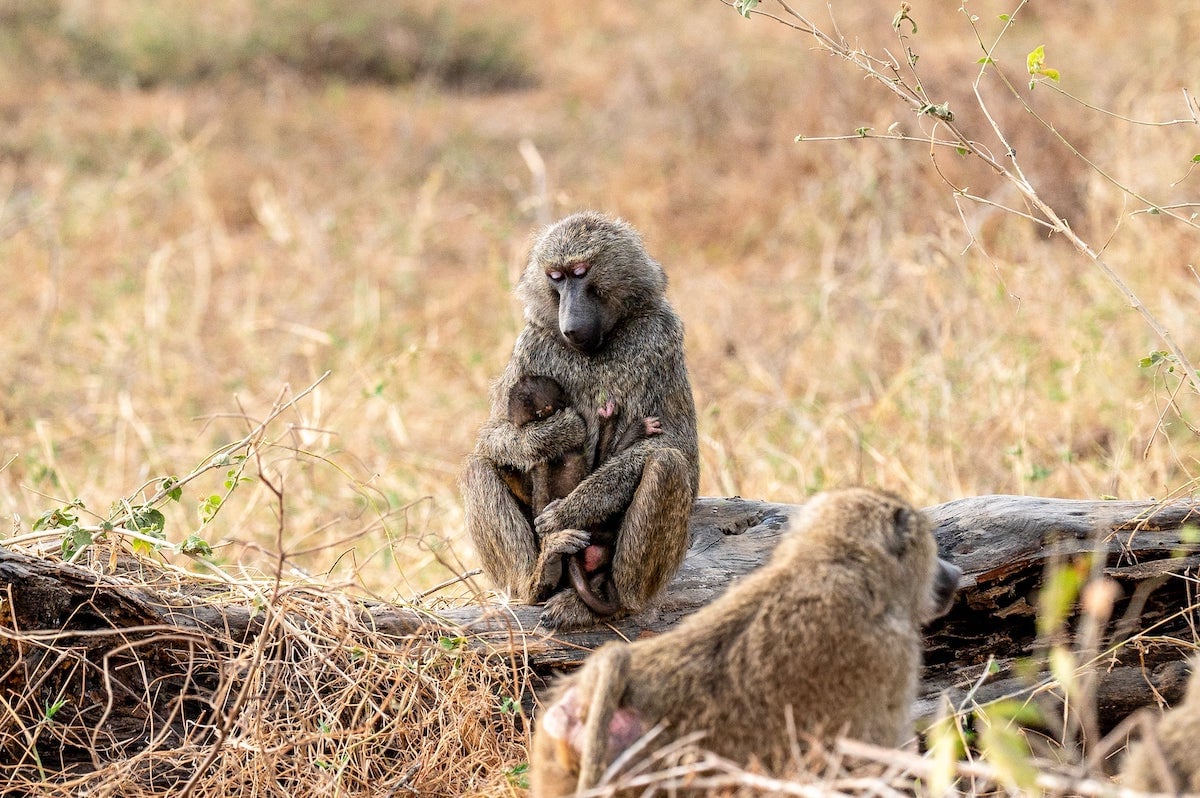
Tanzania Packing List
To help you prepare for your 2 week Tanzania itinerary, here are a few essentials you’ll want to pack. You can also check out my Recommended Safari Packing List on Amazon.
- Day bag (I brought this budget hiking backpack, which I’ve used for years)
- Camera & lenses (if you need to rent gear, LensRentals.com is my go-to)
- I recommend having a zoom lens (~24-70) for landscape shots and a telephoto lens for wildlife shots
- My telephoto lens was 100-400, which was still light enough to handhold, while Andy had some trouble steadying the weight of his 150-600 lens
- Toiletries & medications
- Travel adapter (I use this one)
- Underwear
- Rainjacket (especially if hiking in Kilimanjaro National Park; you’ll also want a jacket if you do the sunrise hot air balloon ride)
- Snacks (I love Cheez-Its, pretzels, granola bars, and trail mix)
- Refillable water bottle (I also brought my Platypus Hydration Bladder for hiking)
- Toilet paper & biodegradable bags (for when bathrooms don’t have toilet paper or trash bins)
- Face mask (to avoid breathing in dust on safari)
- Sunglasses, sunscreen & a safari hat for sun protection
- Insect repellent
- Scarf shawl (this is one of my go-to travel essentials as it can be a scarf, an airplane blanket, and more)
- Bathing suit & pool coverup
- Sneakers, sandals & socks (at least 1 thicker pair of socks if doing the sunrise hot air balloon safari)
- Personally, I packed a pair of hiking sneakers, comfortable sneakers, and strappy sandals
- Layers in neutral, light colors
- My wardrobe mainly consisted of lightweight pants, long skirts, t-shirts (these are amazing), and light zip-ups. I also had a few trendy outfits (like this dark green jumpsuit) for when I wanted to feel cute for dinner.
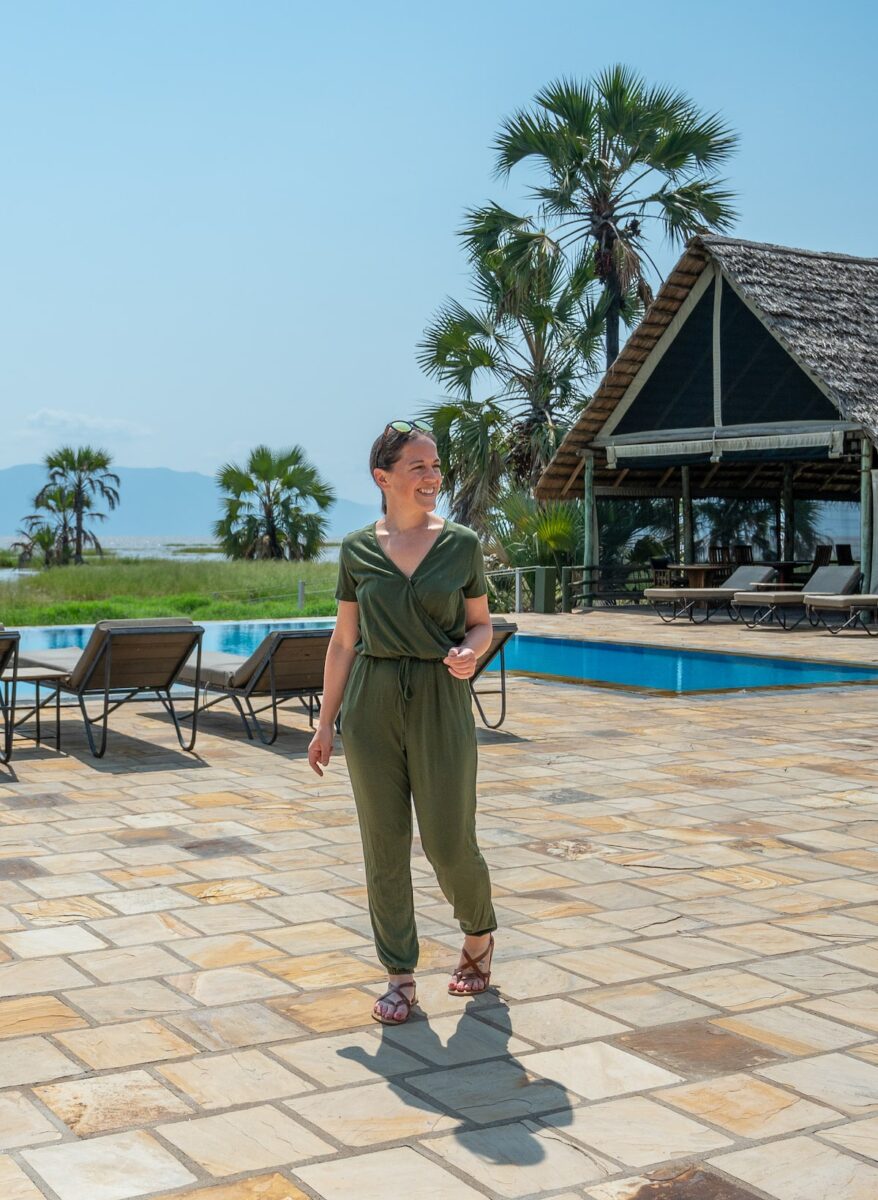
Tanzania Travel Itinerary Planning FAQ
Now let’s go over some frequently asked questions about planning a trip to Tanzania:
Q) Is Tanzania safe for solo female travelers?
Yes, Tanzania is safe for solo female travelers, though consider your comfort level, research the specific places you’re thinking of going, and keep solo travel safety tips in mind.
Q) How many days do you need in Tanzania?
In general, 10-14 days is recommended to really enjoy all that Tanzania has to offer and have a well-rounded trip.
Q) Is Tanzania cheap or expensive?
You can certainly travel Tanzania on a budget if you’re flexible with your itinerary, lodging, and the parks you visit; however, costs can rise quickly with luxury safaris and resorts on Zanzibar.
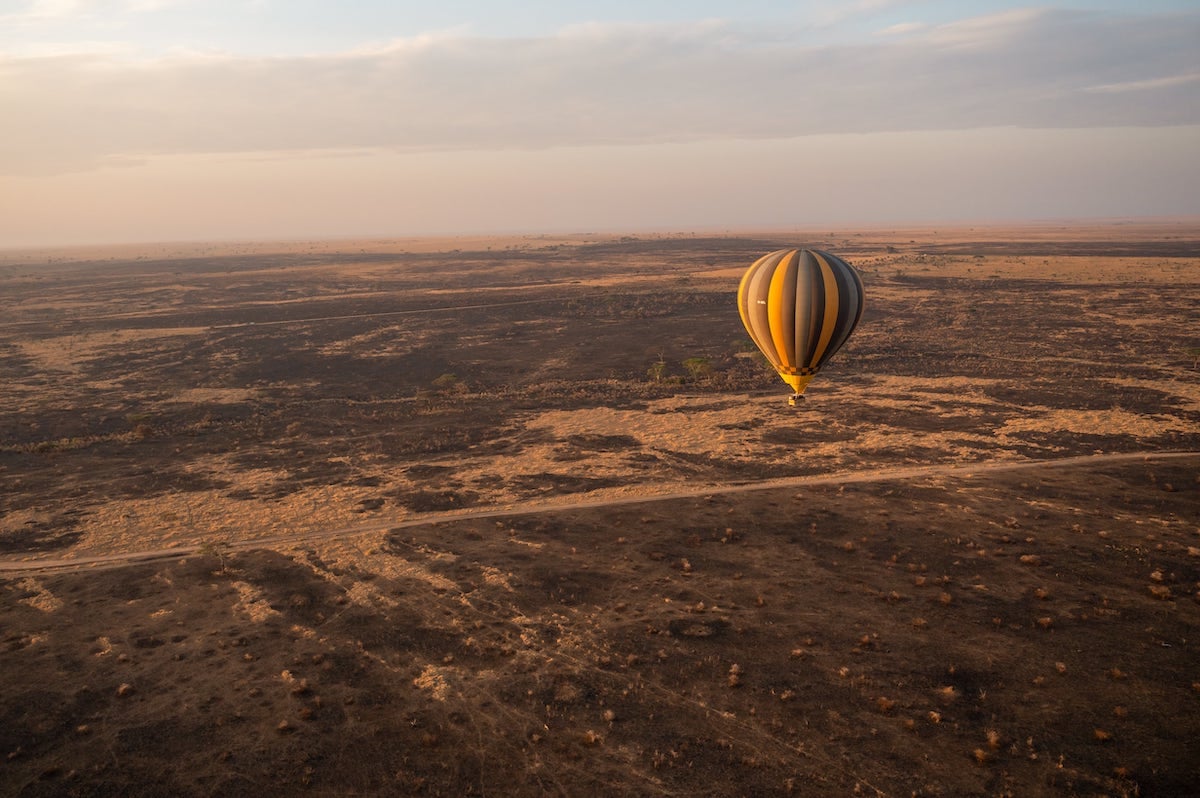
Q) Why is Tanzania so expensive?
One main reason is the park fees are high. Additionally, when you stay at a hotel or lodge within a park you pay an additional concession fee, which is also high, as well as your lodging fees.
Q) Is 2 weeks in Zanzibar too long?
If you have 2 weeks to spend on your itinerary, I’d recommend spending more time on mainland Tanzania and 4-5 days on Zanzibar unless you have many attractions you’re looking to visit on the island.
Q) Is it better to get a Tanzania visa on arrival?
Apply for your visa before your trip to save time on the immigration line when you arrive.
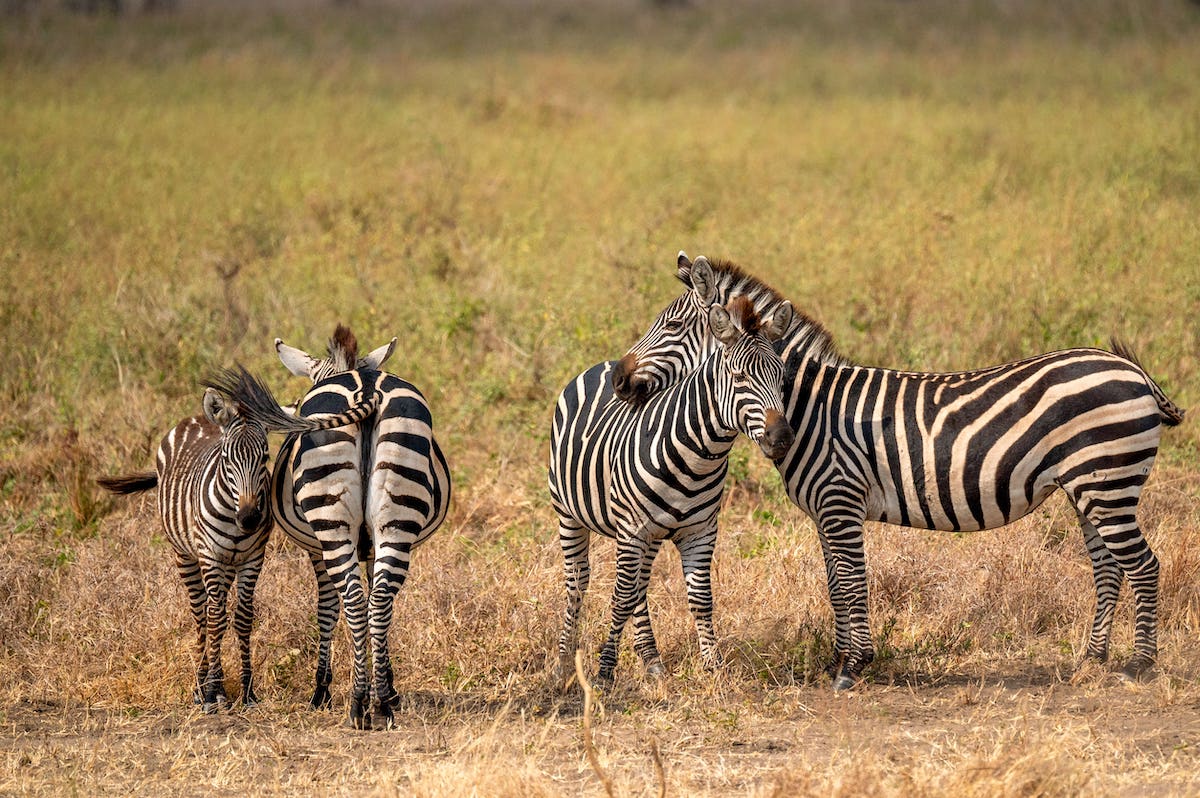
Q) Is Zanzibar in Tanzania?
Yes, Zanzibar is a semi-autonomous region of Tanzania, though it does have its own government, including its own president!
Q) Is Zanzibar safe for tourists?
Zanzibar is generally safe for tourists. Personally, I felt safe while visiting, though it’s smart to always stay aware of your surroundings, respect local customs, and avoid isolated areas, especially at night.
Q) Is it okay to wear shorts in Zanzibar?
While wearing bathing suits and shorts is okay on the popular tourist beaches, like Paje Beach, and at your resort, if you’re going into local villages or visiting Stone Town it is best to keep your knees and shoulders covered as the culture is more conservative.
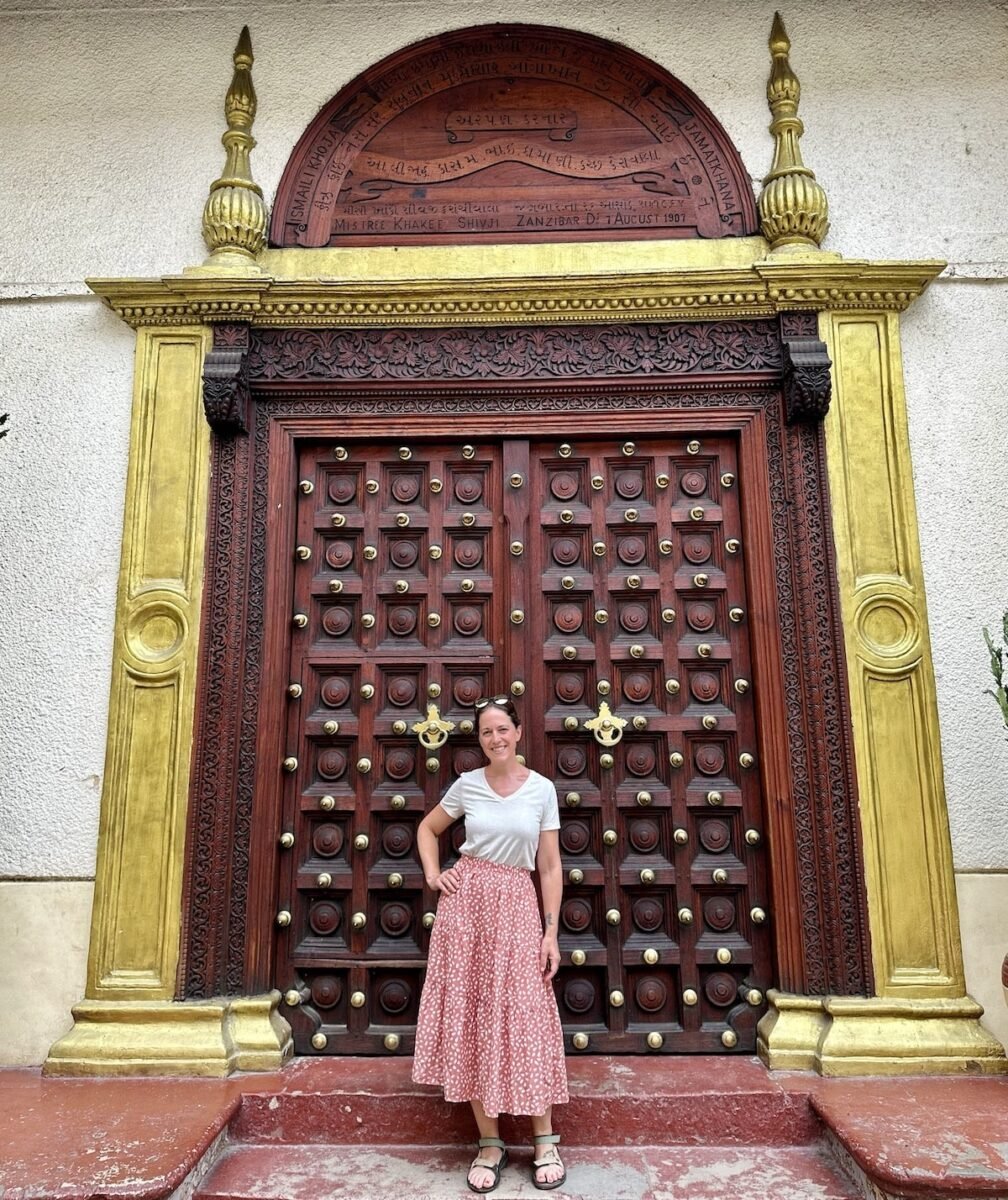
Tanzania Travel Insurance
When spending 2 weeks in Tanzania, it’s recommended to get travel insurance.
For this, I have two recommendations:
SafetyWing. If you’re looking for something straightforward and budget-friendly, you can’t beat SafetyWing. They offer one global policy that you can cancel at any time or continue paying for long-term coverage (making it the perfect option for digital nomads!).
Their plan includes medical coverage, trip interruptions, personal liability, unplanned overnight stays, lost luggage, and more.
World Nomads. For something more comprehensive, World Nomads is a great option. While you’ll pay a bit more, you’ll typically get higher coverage maximums as well as additional inclusions—like trip cancellation.
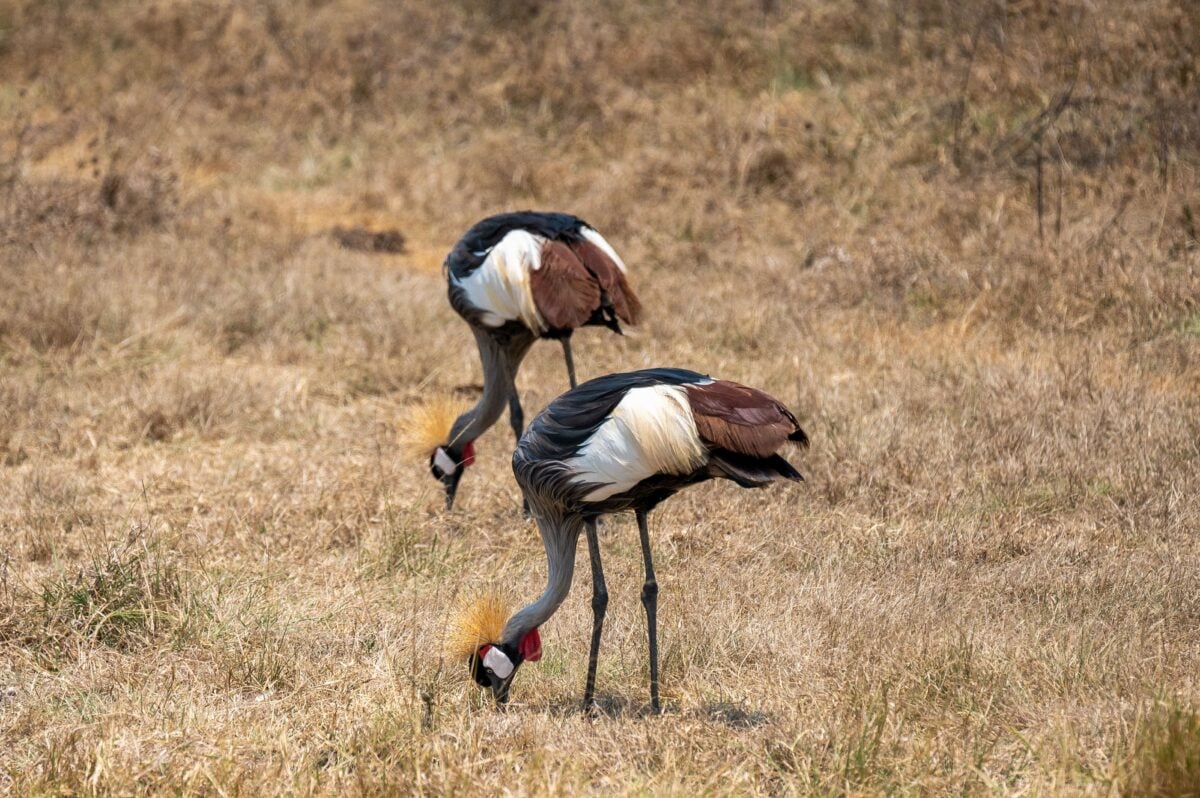
Final Thoughts On Spending 2 Weeks In Tanzania
Hopefully, this itinerary for 2 weeks in Tanzania has you excited to explore this beautiful country. From hiking Mount Kilimanjaro to seeing wildlife in the Serengeti to relaxing on the white sand beaches of Zanzibar, there is so much to experience.
Remember that this itinerary can be adapted to fit your interests. Maybe you want to summit Mount Kilimanjaro and don’t really care about beaches. In that case, add on to the beginning of the itinerary and cut off the end.
Or maybe you’d prefer to do a 2 week safari in Tanzania and skip everything else. It’s all up to you!

